The Odyssey
| « Questions about organizational culture | The Grip Truck » |
Or: How to put together a complex show in seven weeks or less in a new-to-us theater after having previously retired from theater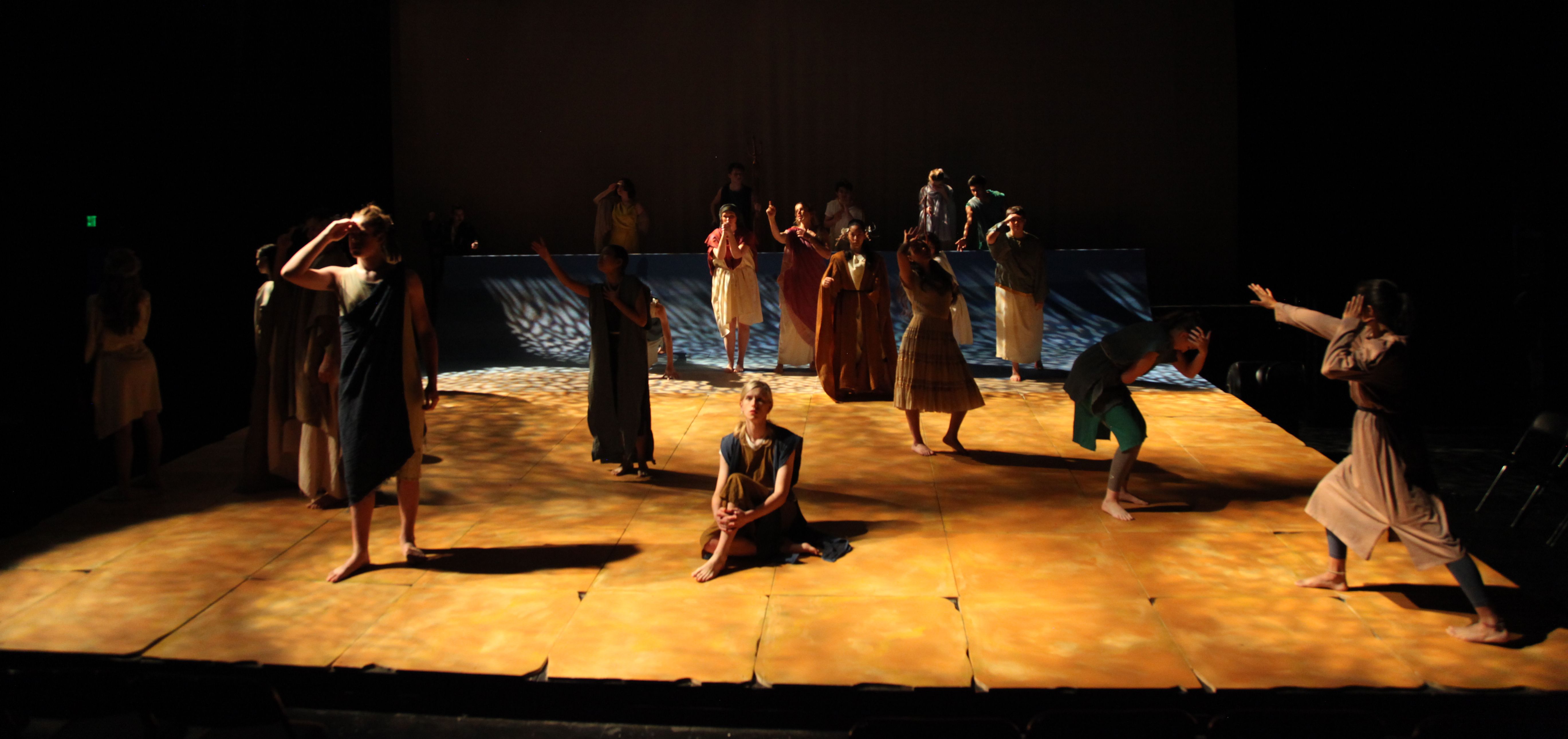
September 14th, 2021 - T minus 8 weeks
I've been asked whether I'd be interested in helping out our local high school's theater program with tech for their next production.
As much as I've been trying to get out of the theater and into filmmaking, this seems like a fun opportunity to do some good, so let's see what happens.
September 23rd, 2021 - T minus 7 weeks
I meet with Daniela, the head (and, really, only staff member at the time) of the drama program. This joint turns out to be one of the nicest theaters I have ever worked in, right after McCarter in New Jersey and ACT's main stage in Seattle. This is definitely worth taking a break from filmmaking for.
The production is Mary Zimmerman's The Odyssey, which my wife Sarah has long been in love with, adding to the excitement. Daniela and I make a handshake agreement that Sarah and I will deal with all aspects of set and lights, and the work begins.
The set
September 30th, 2021 - T minus 6 weeks
Sarah and I start mapping out the space from old drawings and new measurements. There's very little accurate paperwork. I use Fusion360 to begin modeling the space for our set and lighting designs - not a program I'd necessarily recommend for this but I've been using it for 3D printing so it's still fresh(-ish) in my brain.
The production is supposed to take place in a quasi-blackbox position with the audience seated on stage around a central playing area. We decide to create a raked stage with an upstage wave (an idea I stole from a production of A Winter's Tale I saw at the Delacorte in NYC some twenty years ago) to marry The Odyssey's land and ocean themes into a single space. There'll also be another platform above the wave for The Gods as well as entrances and exits over said wave.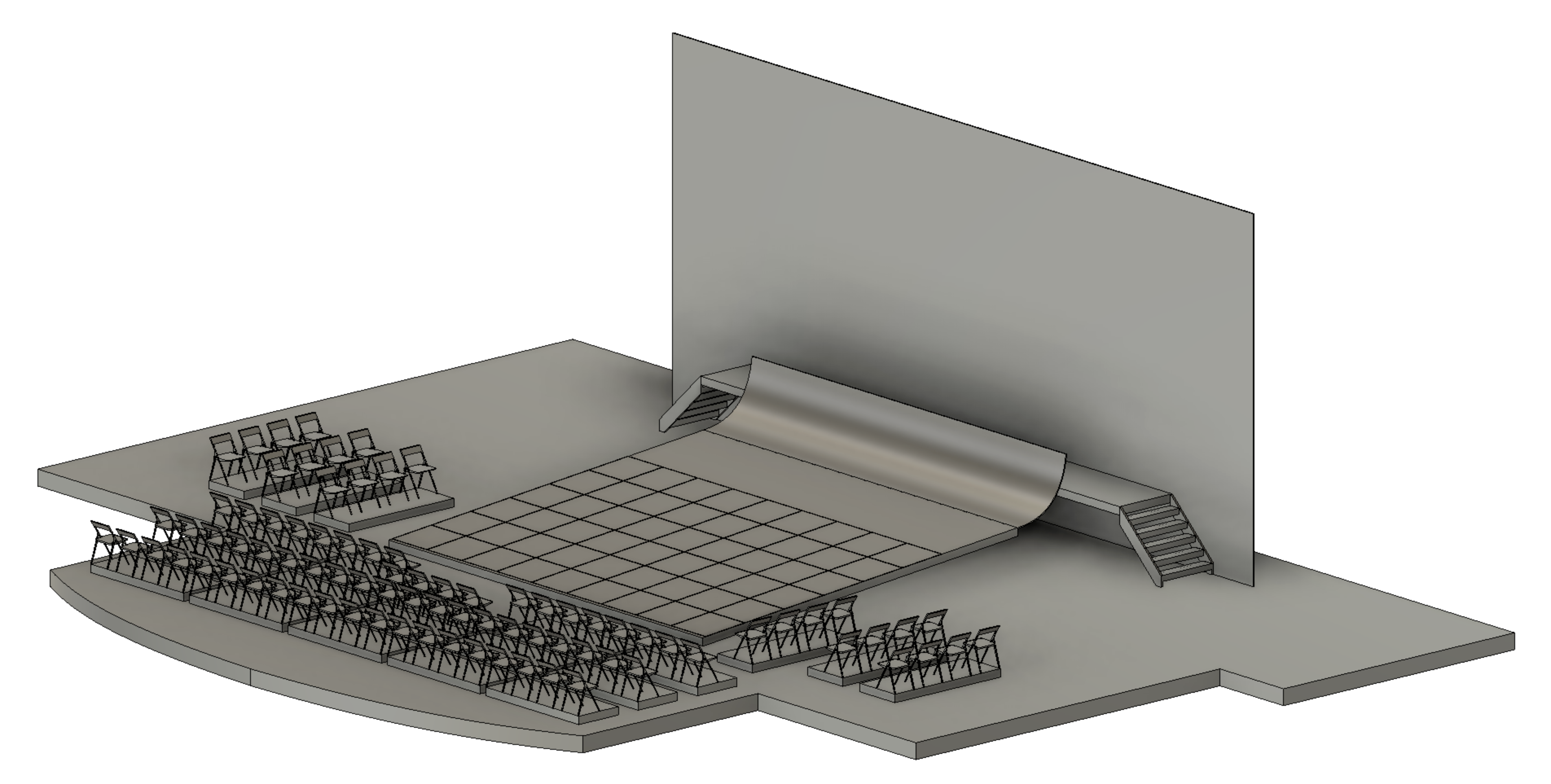
Much noodling goes into the shape of the rake and wave, balancing the desire for incline (to provide visibility for upstage actors) against walkability/safety, and also just the money we need to spend on legs for all the platforms.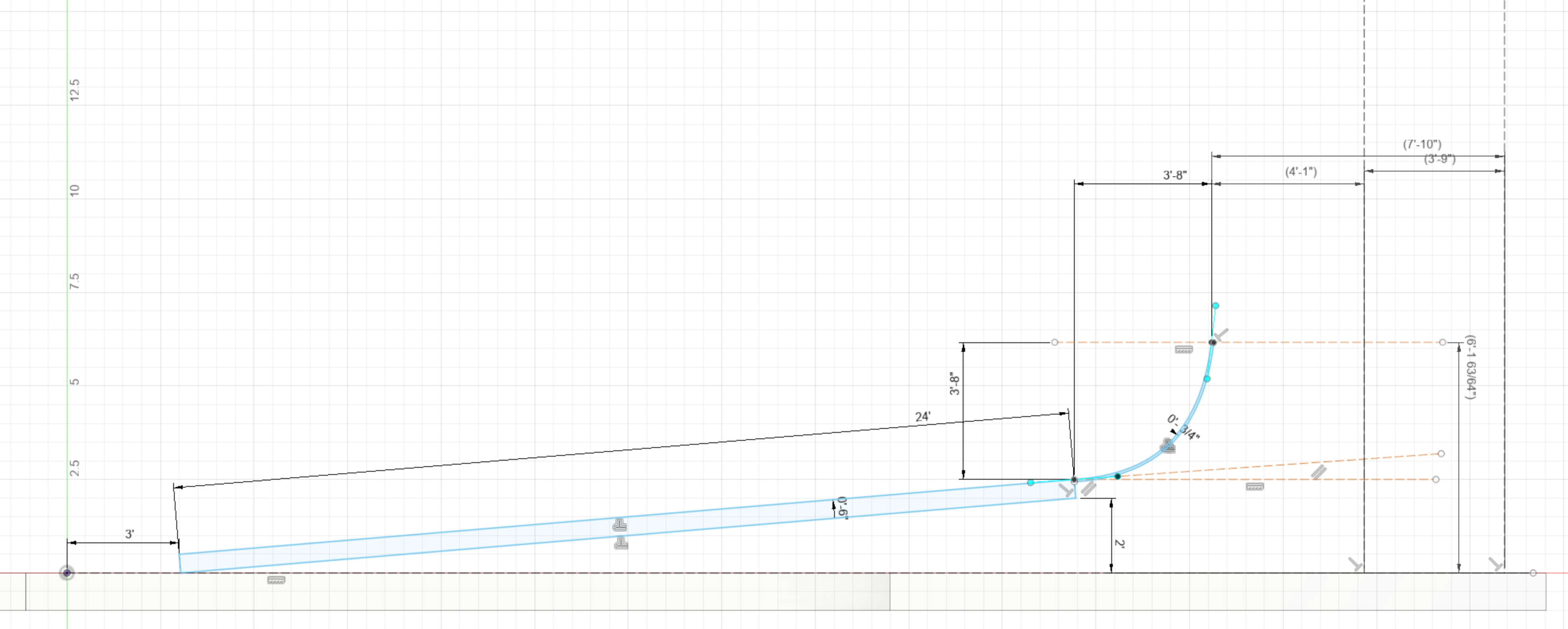
I then spend a few hours watching YouTube videos to learn how skater ramps are built and settle on using plywood ribs every 4' with 2x4's spanning them every ~12", skinned with two layers of 3/8" plywood, which is just bendable enough. I tune the shape of the wave so that I can cut three ribs out of each sheet of 3/4" plywood.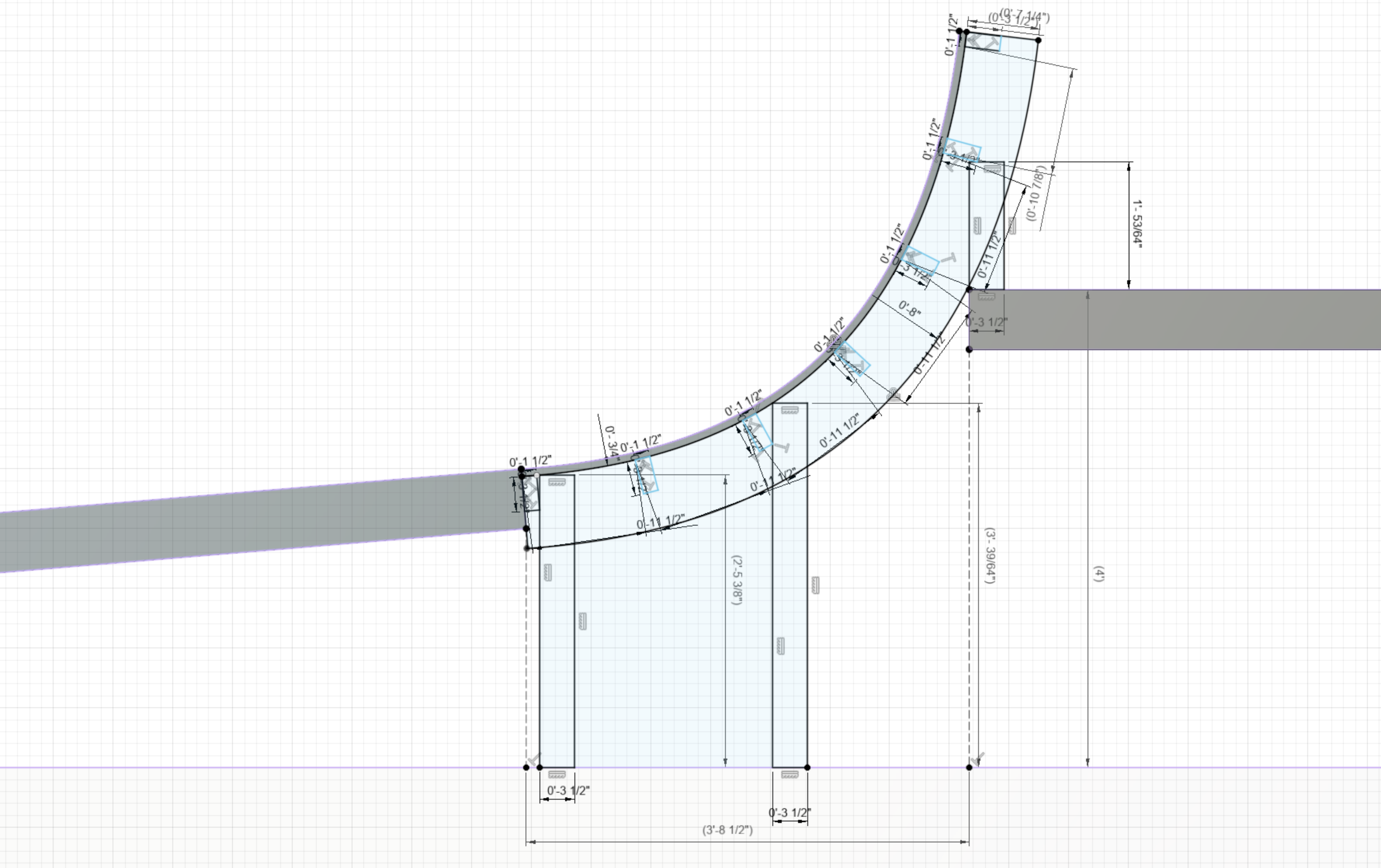
October 16th, 2021 - T minus 4 weeks
Time to spend some money. I use my grip truck to pick up a pile of plywood and 2x4s.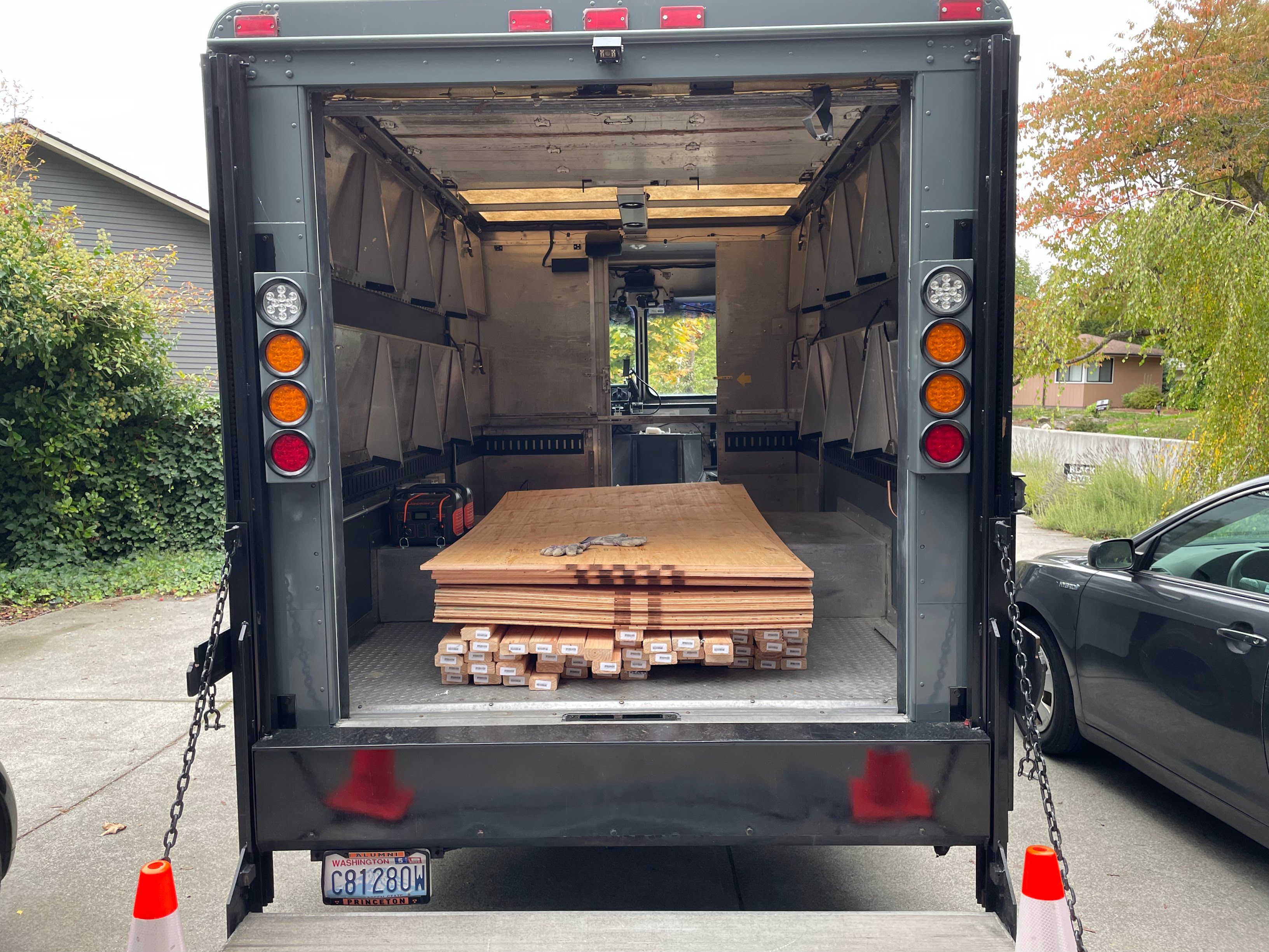
Then I print a 1:1 drawing of the rib with alignment marks for the 2x4s and spray-glue it to a sheet of plywood to make a primary rib.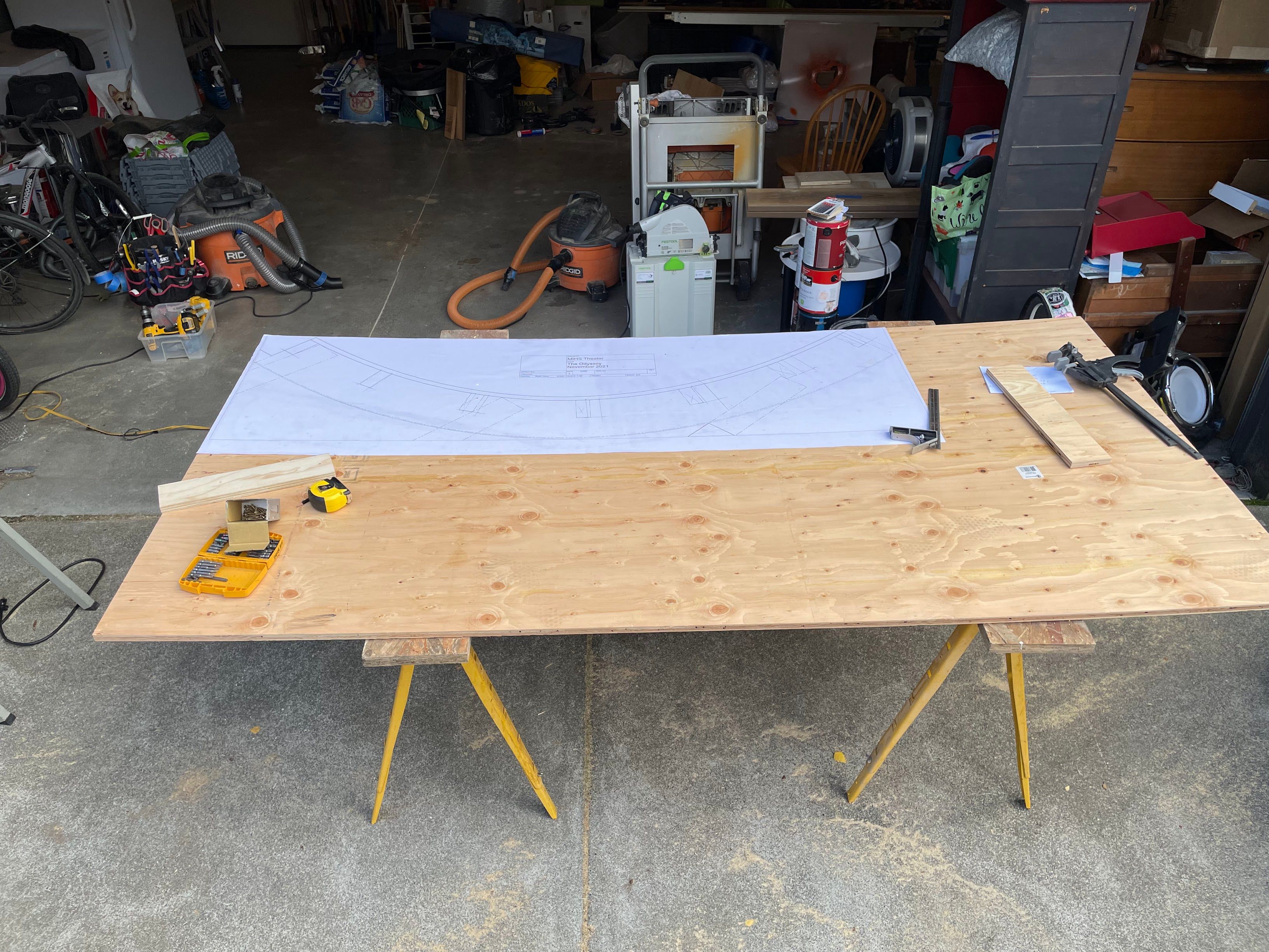
Much cutting and duplicating (tracing, jig saw rough cut, and router + flush trim bit copying) later, I start assembling the wave.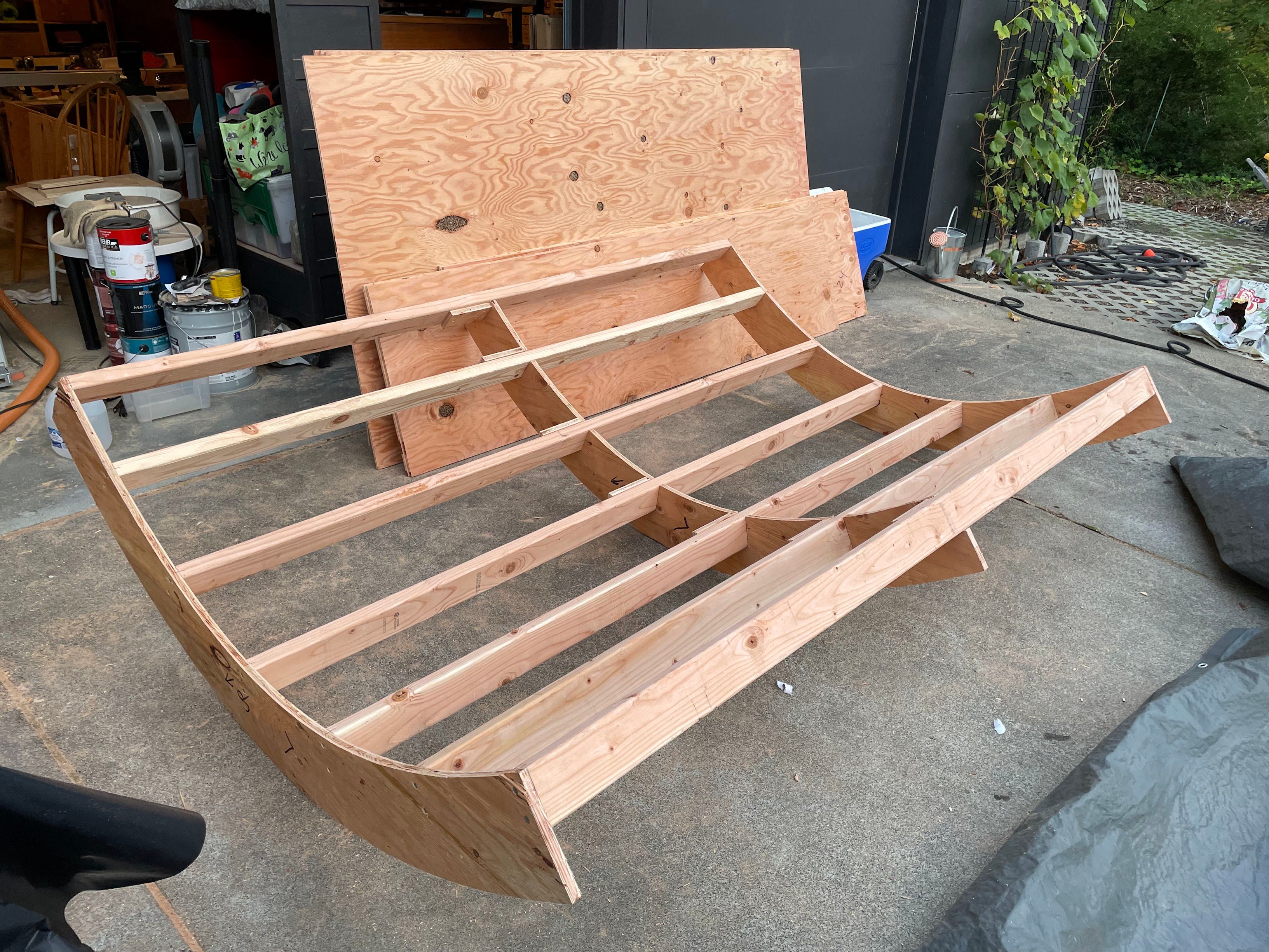
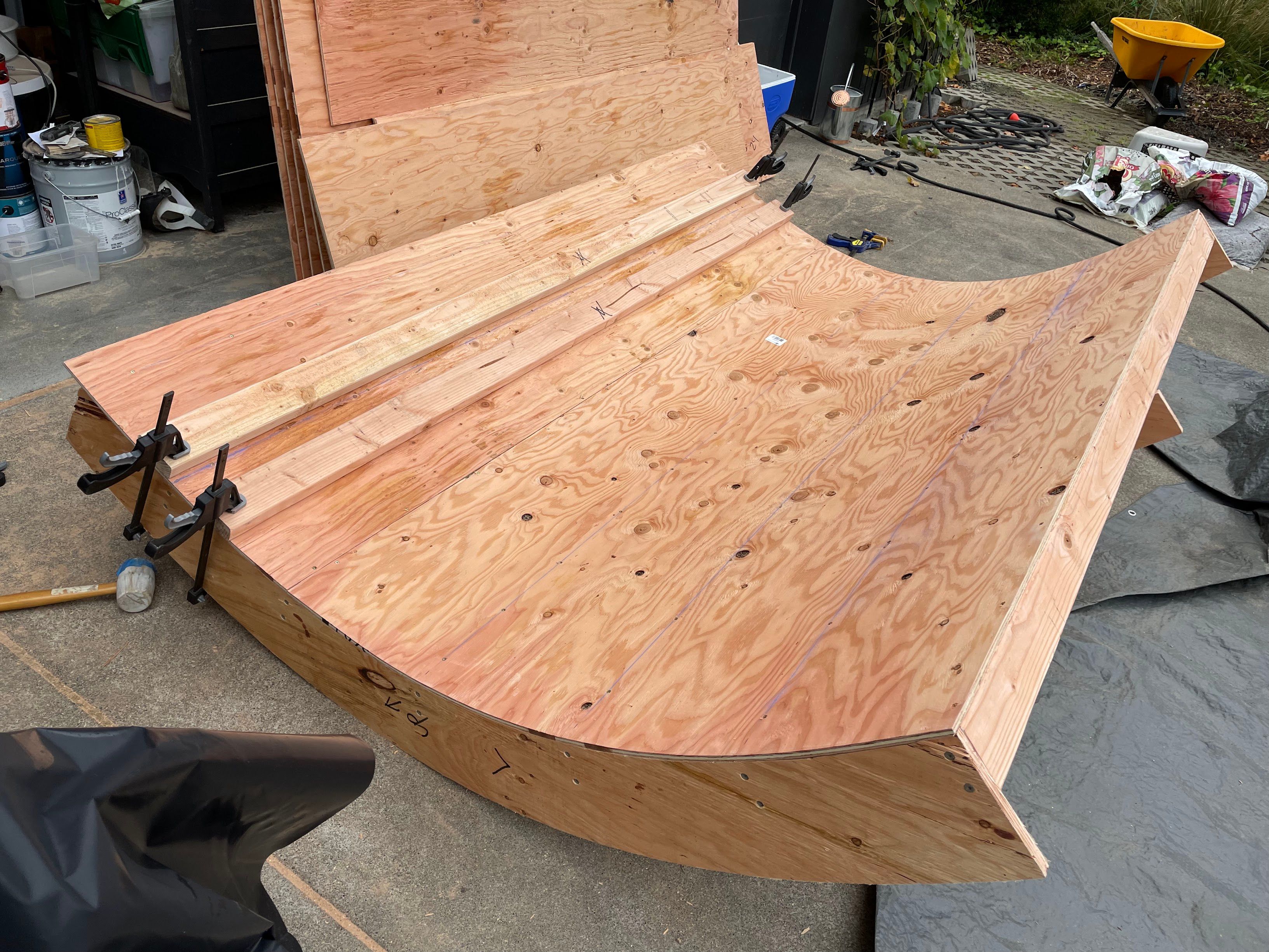
October 27th, 2021 - T minus 2 weeks
I've built three and a half pieces of wave to cover the 27' width of stage, chucked them back in the grip truck, and driven them to the theater. Sarah and I (largely by ourselves) assemble 27 stock 3'x8' (don't ask) platforms into a 27' wide, 24' deep rake. We assemble the 32' wide god platform and suspend the wave inbetween the rake and god platforms.
I also build two 4' tall staircase units so folks can get onto the god platform. I'm not a huge fan of building staircases but so it goes. (Months from now we'll find out that the orchestra pit had loads of staircase units in them, we just didn't know that we should look there. Hah!)
Sarah takes a big pile of old 3/4" particleboard sheets and cuts them into 3'x3' tiles, distresses the edges with a belt sander, and screws them on the downstage two-thirds of the rake to look like stone tile.
November 6th, 2021 - T minus 1 week
Tech day! The set is mostly together, though we're still working on properly covering the seams in the wave units in the back.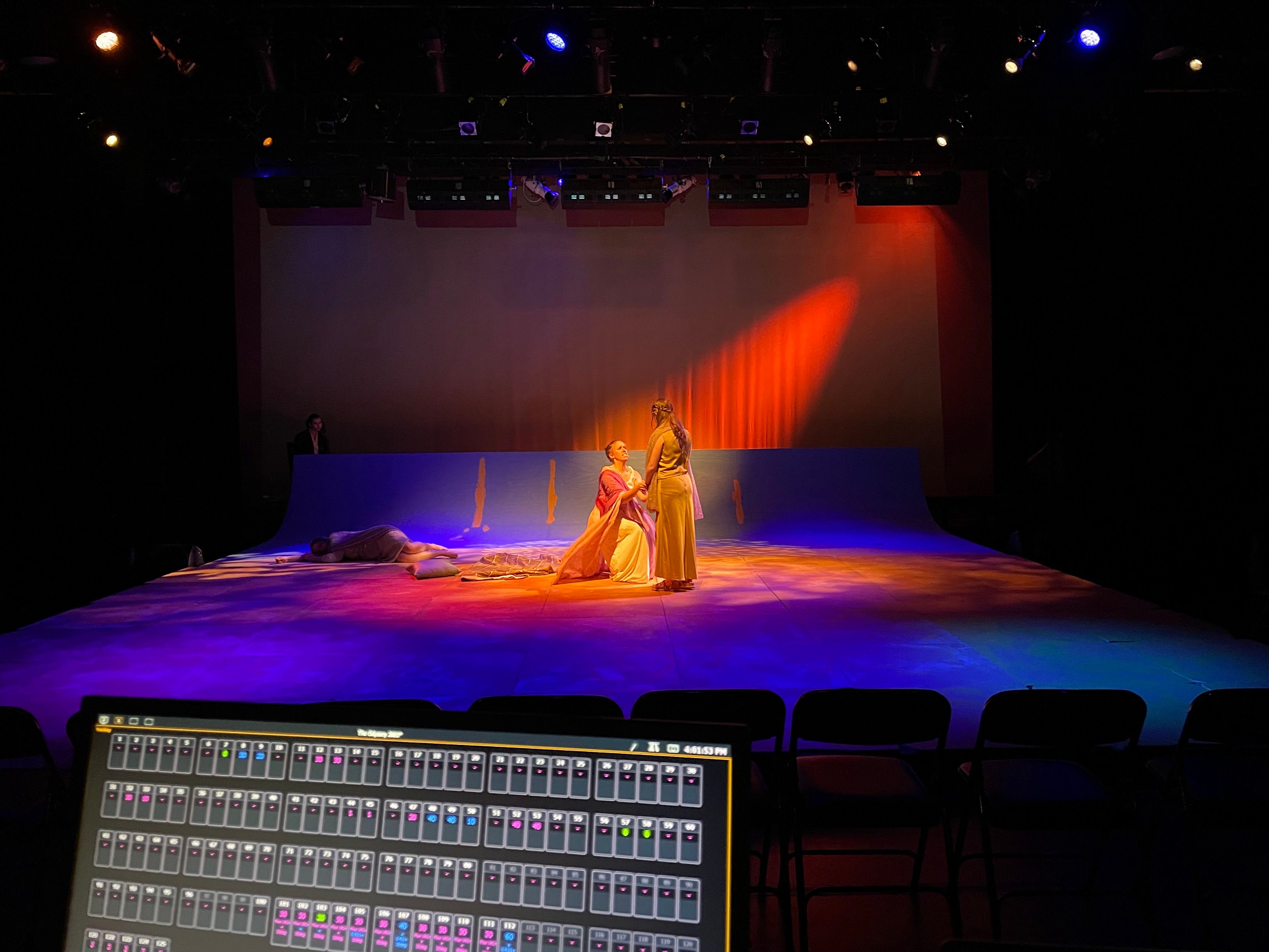
To our eternal chagrin, our attempts to use gaff tape to cover the seams don't work and I reach for left-over floor patch compound from the cottage project. It works, but we don't get around to painting it until just before opening night, so all the photos taken of the production show a big shit-colored streak up the wave from the unpainted compound. Lovely.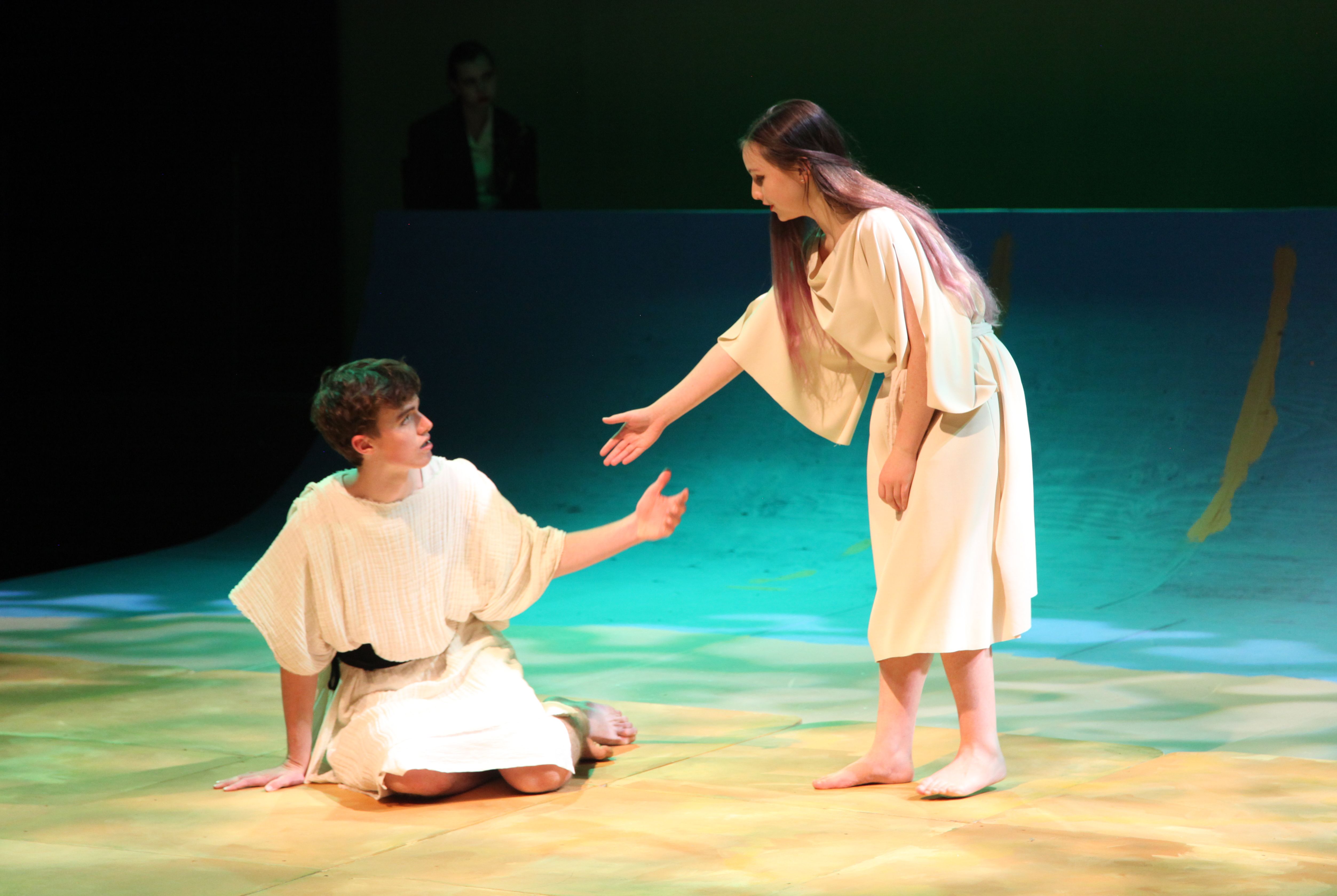
The lights
Earlier October, 2021 - T minus 5-ish weeks
The venue has a reasonable inventory of lighting instruments (about 150 units, including 40 Source4's) though it's all hung rather strangely. I suspect that whoever worked here last really liked front light and didn't pay much attention to side light, so all the Source4's are front light, all the old and crap ellipsoidals are sitting around doing nothing, and a bunch of fresnels provide a middling-at-best level of color and control over stage.
Time to strip the pipes bare and start over.
I decide that this is the perfect opportunity to buy something I've wanted for a long time: LED moving lights. I had used some Martin MAC Auras a couple years ago and really liked them, and the pandemic made used moving lights somewhat more affordable: With the global shutdown, rental houses pulled their gear, invested in newer models, and started selling their older versions on the somewhat-cheap.
With the help of the amazing Michael Ferguson at Christie Lites, I am able to obtain 12 MAC Aura's, shipped up just in time for tech from Las Vegas. (We will not speak of how much shipping cost.)
October 25, 2021 - T minus 2-ish weeks
I put together detailed paperwork starting with a list of scenes.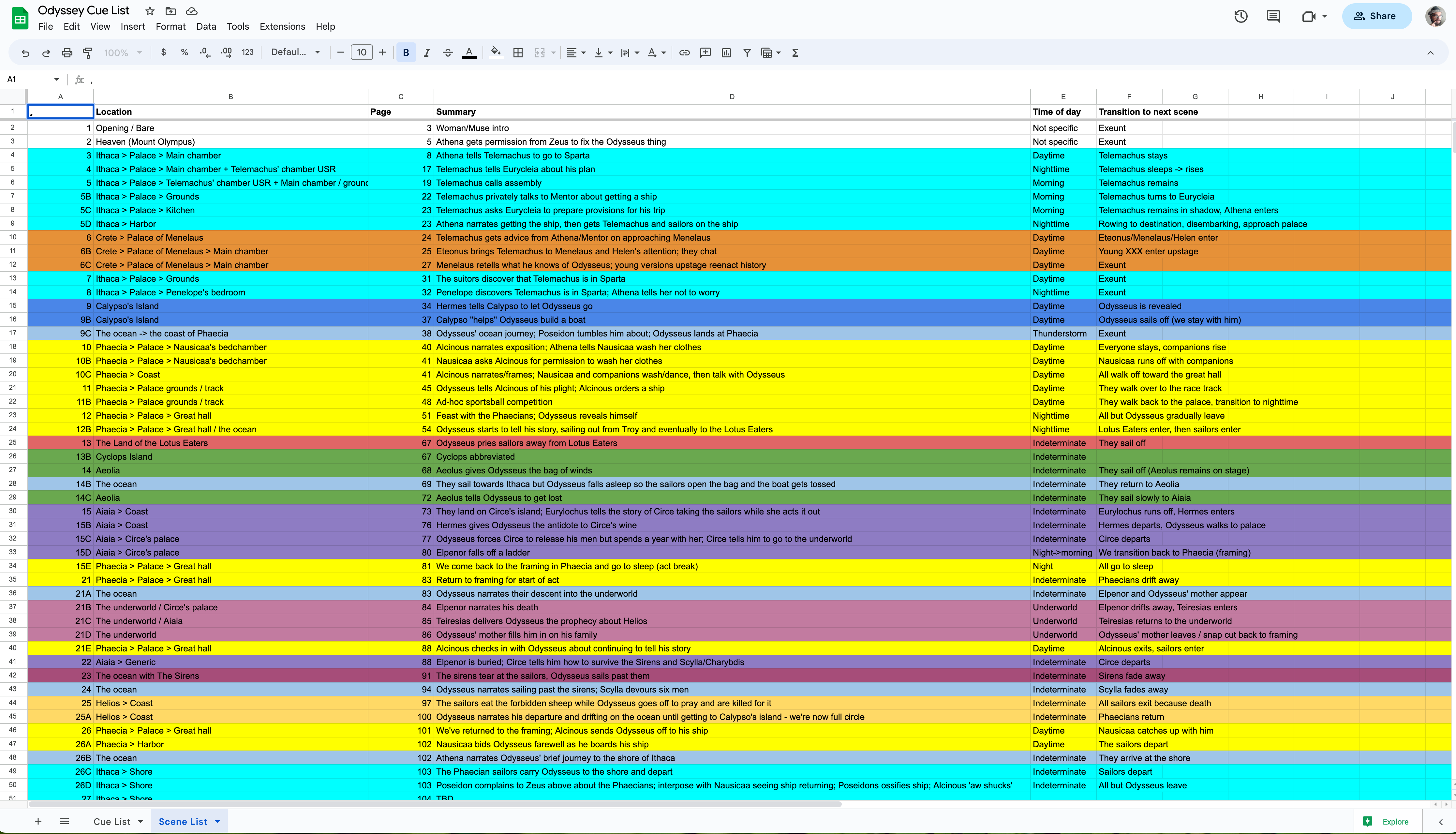
We do paper tech so I can figure out where the actors will enter/play/exit, how small or large the acting areas will be, and what the lights actually need to be able to do. The more theater I do, the more valuable I find this exercise, and the earlier in the rehearsal and design process I try to push it. (This - two weeks before opening - is not early, but it's the best we got.)
The cue list sheet pulls the scene location and description text from the scene list automatically based on the scene number - quite handy.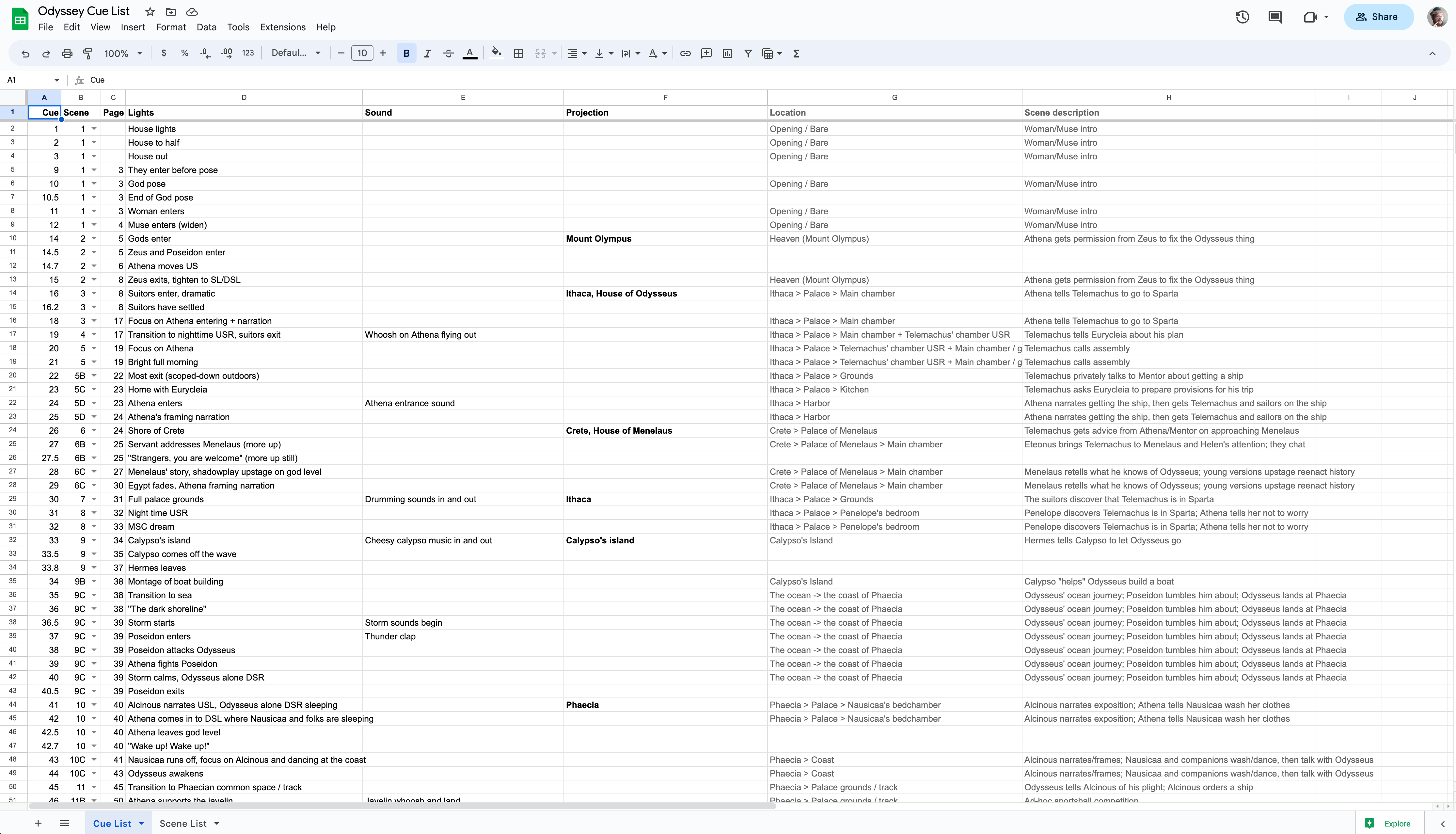
With a firm idea of what things ought to look like and what the lights need to be able to do, I can turn back towards the engineering side of lighting design.
My light plot establishes a grid of 4 rows of 5 columns of side/side/front/back light. I use Source4's for the side light so I can stuff templates in them - this is going to be a dark show so there best be lots of pretty texture.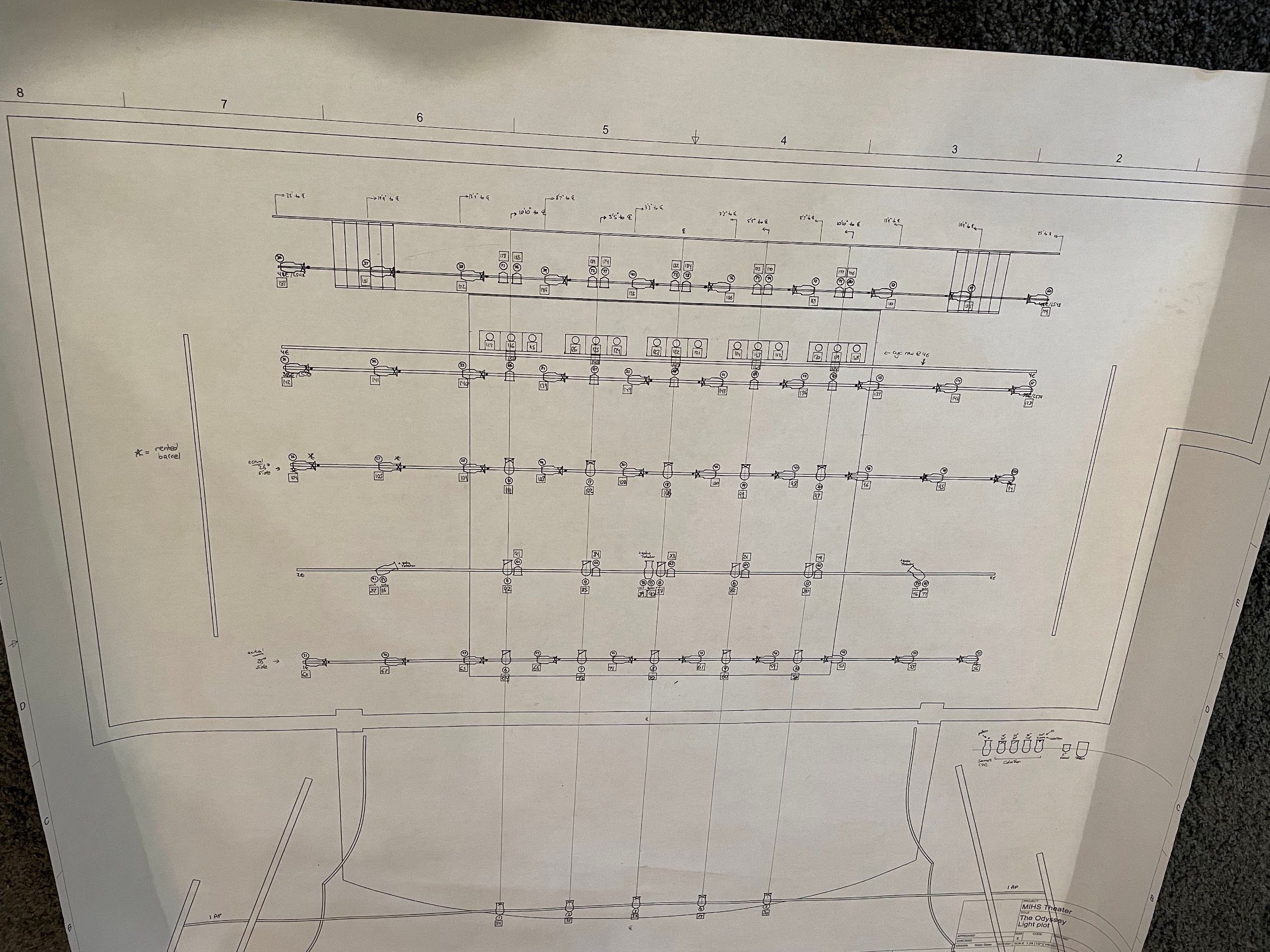
The run-up to tech is a bit harrowing: the moving lights arrive just in time, as do all the DMX and power cables I need. I've "permanently borrowed" most of the Source4 inventory of the late Microsoft Theater Troupe, so I contribute ten white (!) Source4's from that for the upstage-most row of side light. I also find a place for some gobo rotators I'd bought for my filmmaking adventures and slap those into two 50-degree Source4's I'd bought when I first moved to Seattle and plain missed doing theater.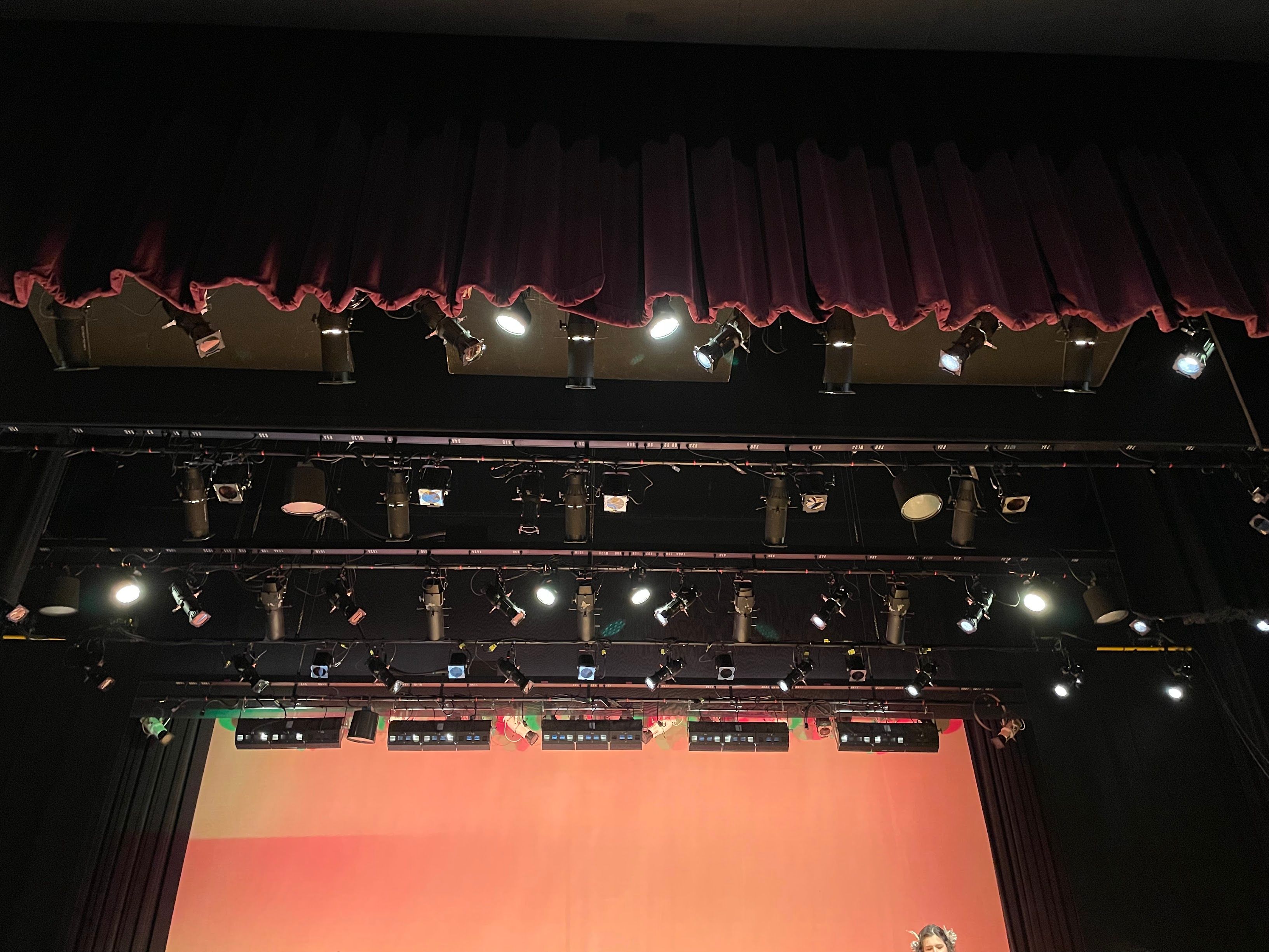
November 6th, 2021 - Tech!
Writing cues is where my artistic and engineering brains get to run side-by-side with tremendous focus and intensity for long hours (nine hours, for this production) and I low-key love it.
I much prefer writing cues during tech with everyone there: it really brings me into the vibe of the show (on an artistic level) and writing cues without actors present also plain doesn't work (on a mechanical level) because we're lighting people after all and not the floor. That said, this is a bit of a high-risk proposition so I've developed some techniques to manage that risk.
The first show I ever used moving lights on, I had essentially zero focus points programmed when we started tech; in part because I didn't know any better, and in part because I just hadn't had the time because load-in had been a shit show. I had a near-panic attack and was only able to get through the evening with the help of a whole lot of cheap boxed wine, which I don't really recommend as a regular coping mechanism. As a result, I nowadays program a stupendous amount of focus points before the cue writing process begins. I suspect the high school would frown upon boxed wine.
I also take some time with the lights before tech and see how the set responds to being lit. How do the colors and textures interact? How do different directions of light reflect off different floors, walls, and everything in between?
This is also a great time to memorize what all the 100+ lights do so that by the time I'm writing cues, I can look at any piece of the stage and immediately know what channels control the lights from each direction without having to think about it.
With all this prep, tech blessedly goes very well. Every cue gets written. The director is very happy. Most importantly, I get to be the kind of person I want to be: calm, focused, friendly.
November 11th, 2021 - Opening night
The show is really, really good. The students are doing an amazing job with the material, which is not easy. The leads have memorized mountains of lines and are delivering them excellently.
The tech doesn't suck, either, and the set and lights are proving as versatile as I'd hoped they would be.
The grid system lets me expand or contract the audience's focus in whichever way serves the story best. The templates/patterns/gobos in the side light can be pronounced and moody, or I can wash them back out with top light while retaining the side light's edge definition.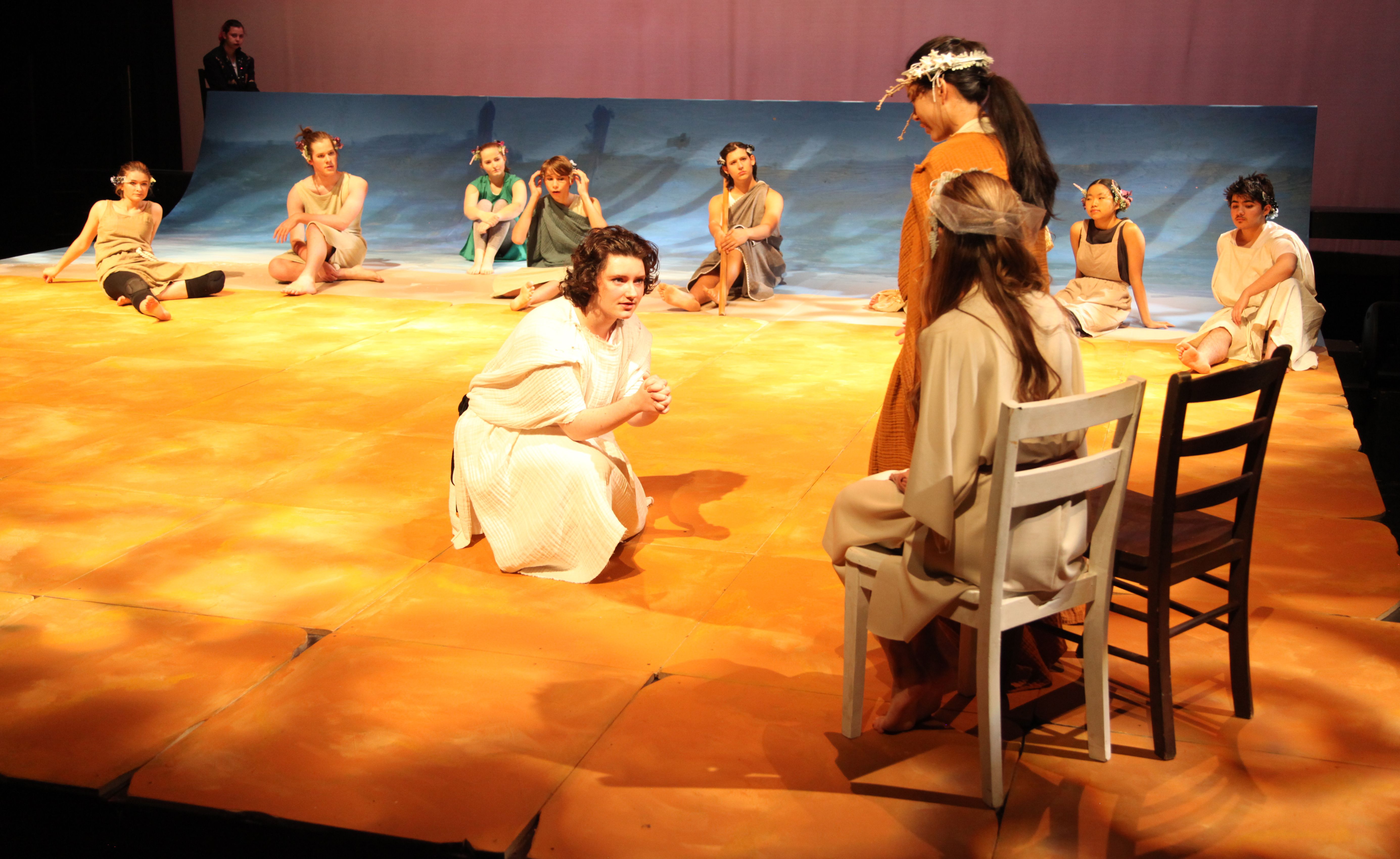
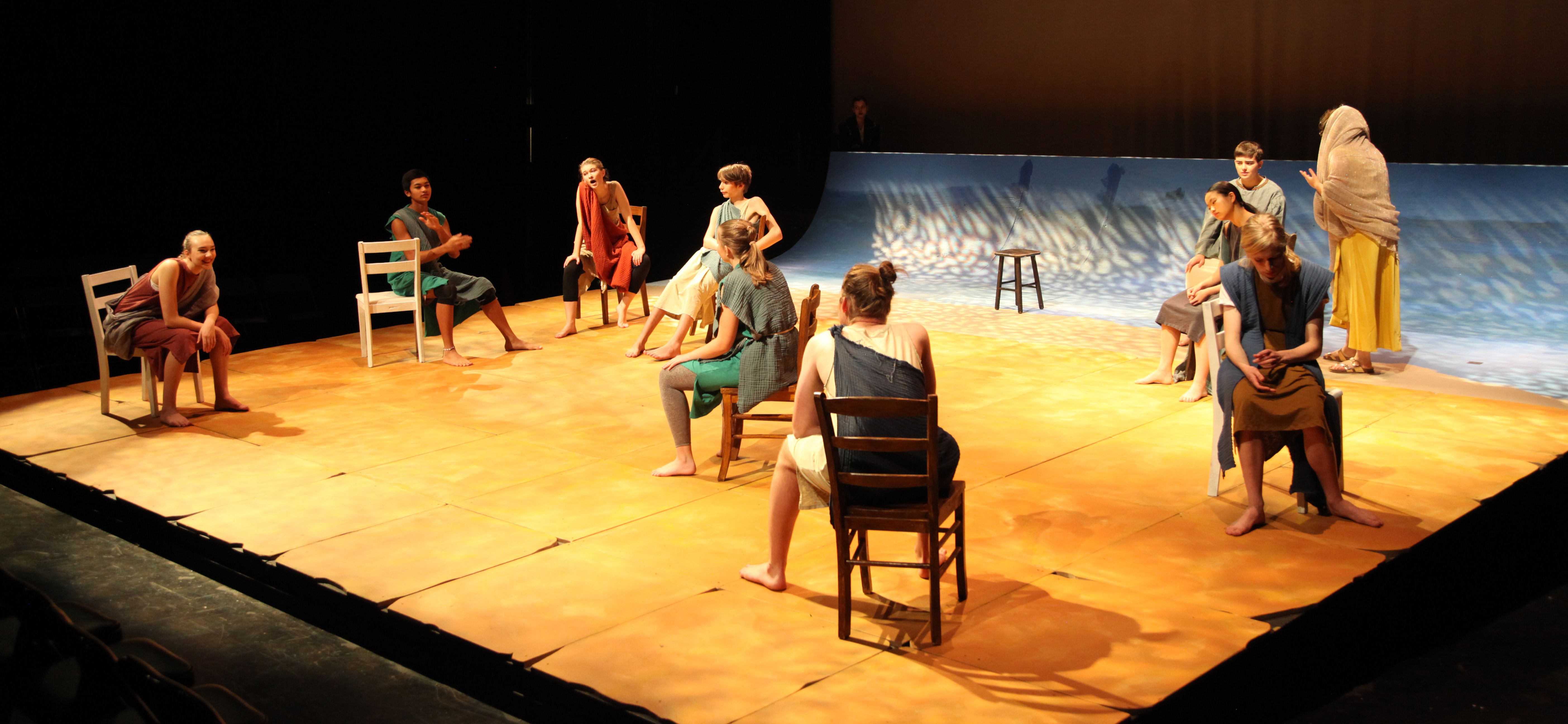
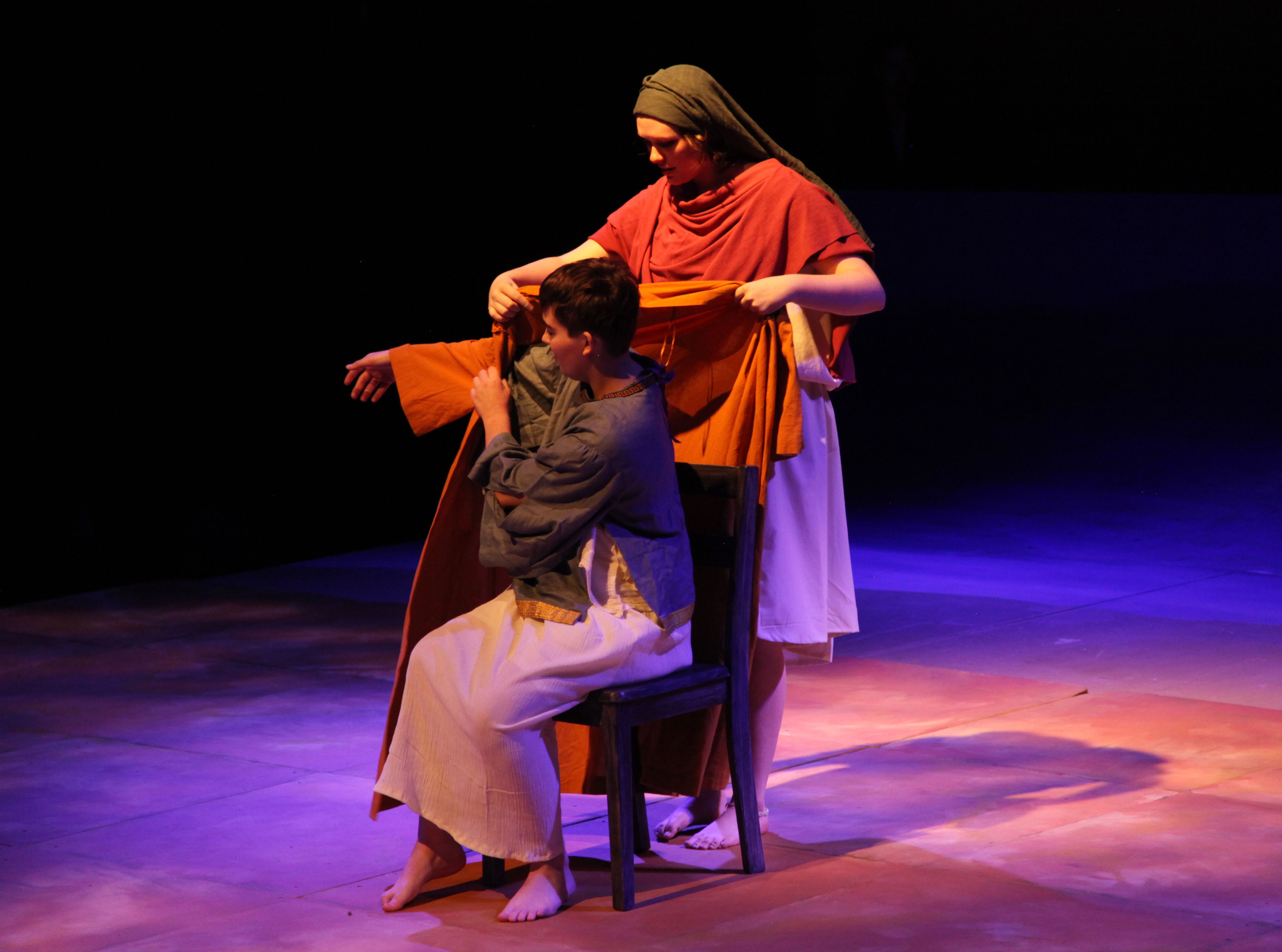
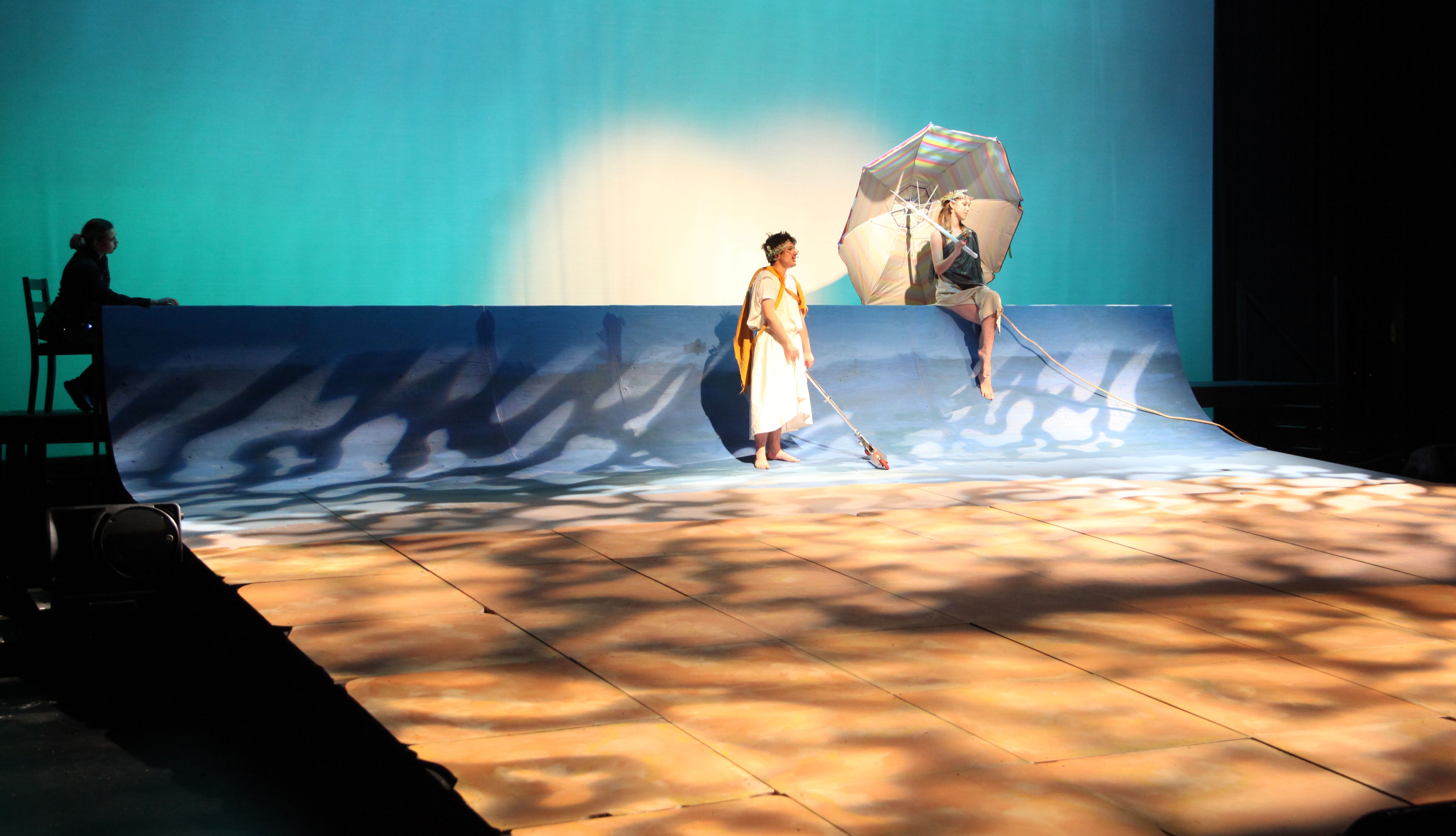
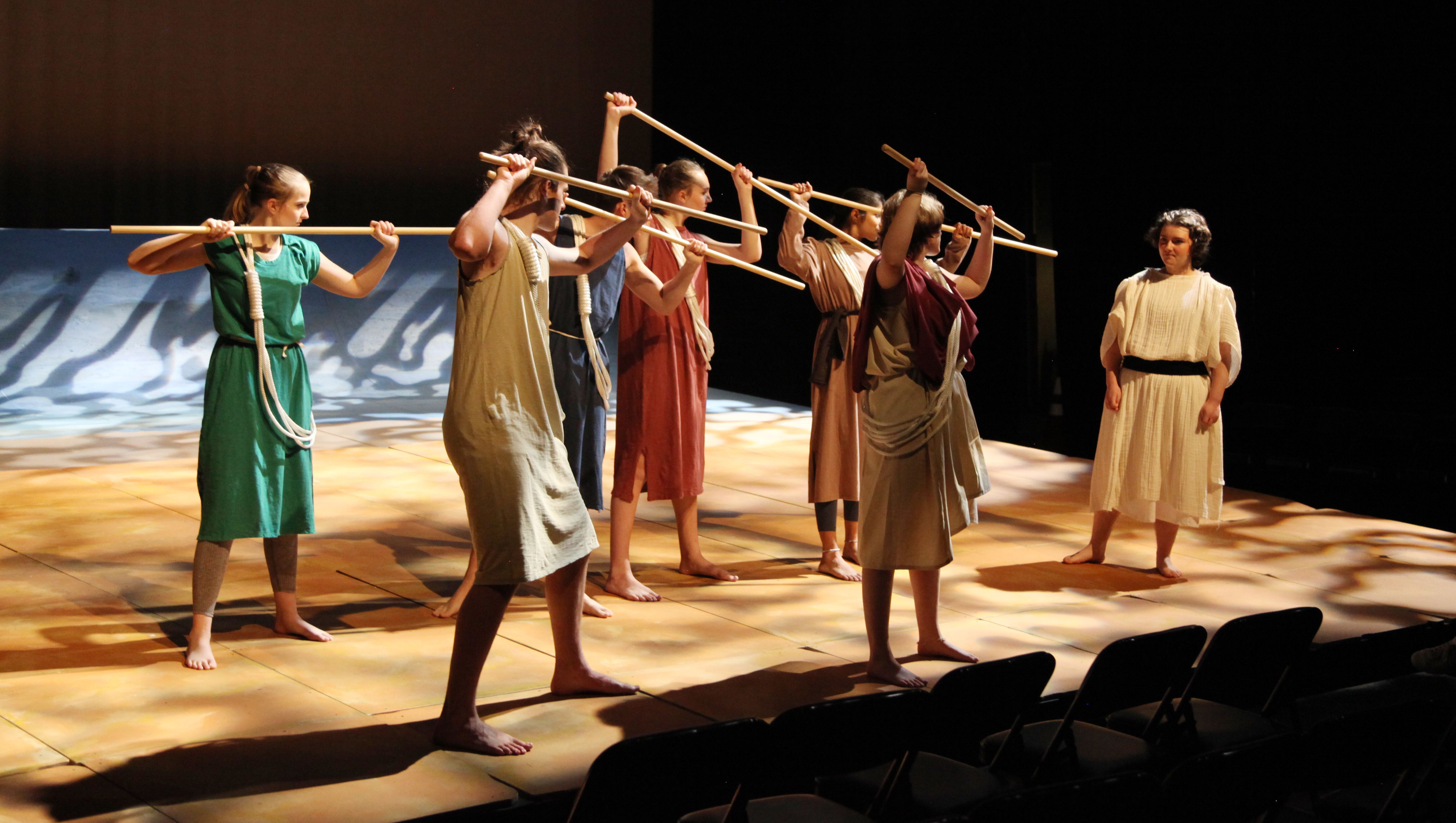
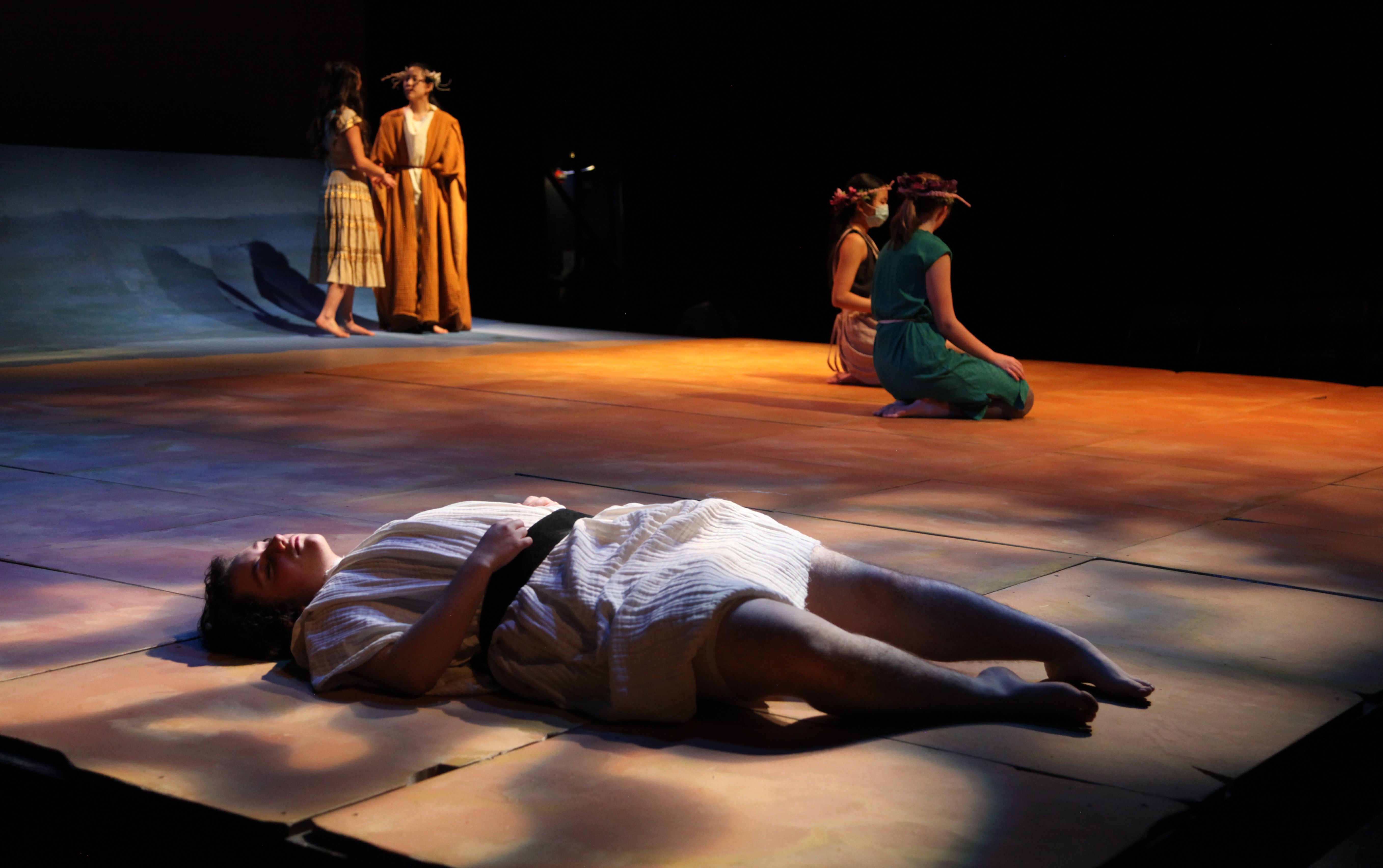
The versatility of the moving lights helps me paint people and spaces with color (the only color in the entire show comes from those little MAC Auras).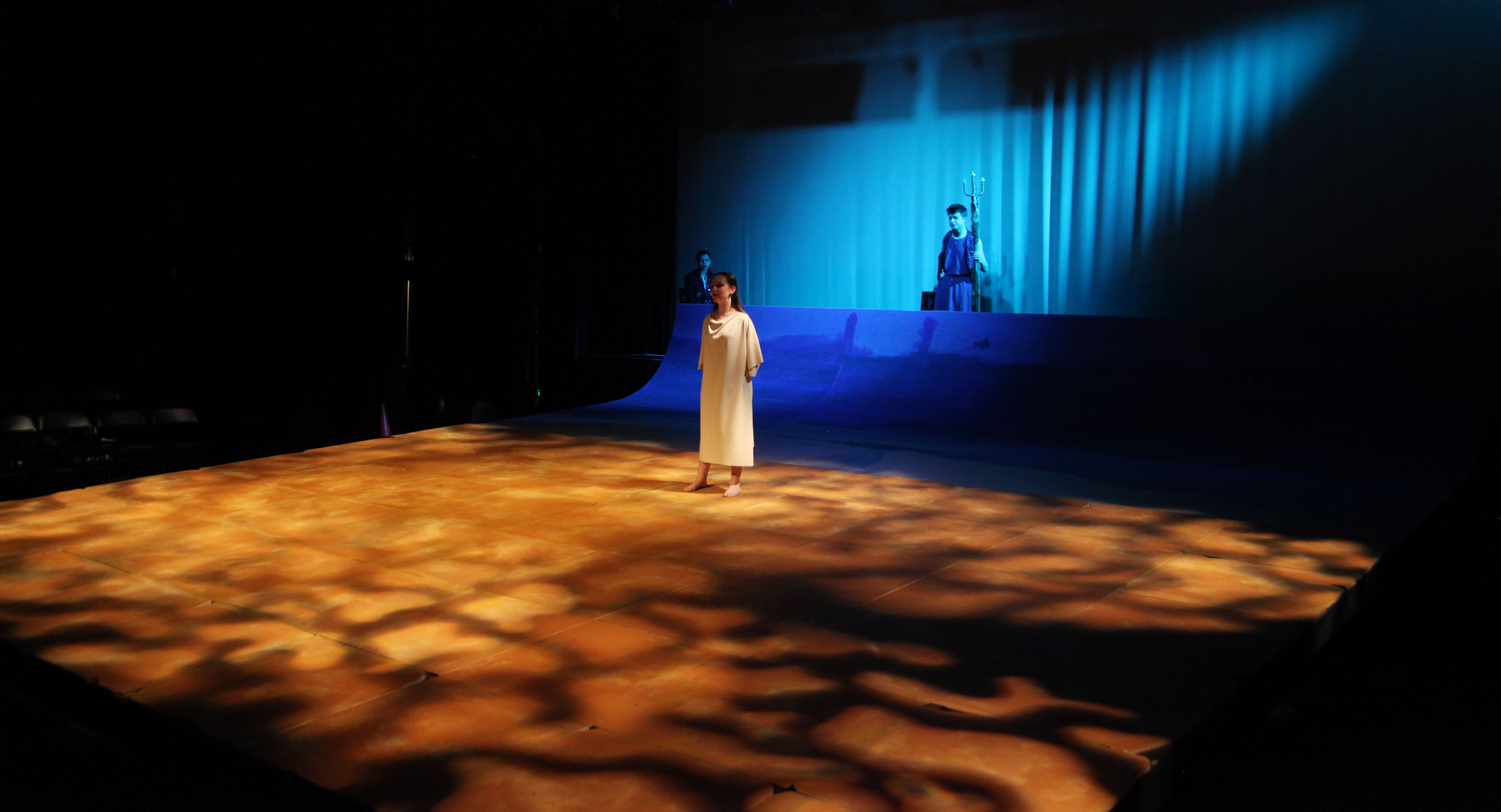
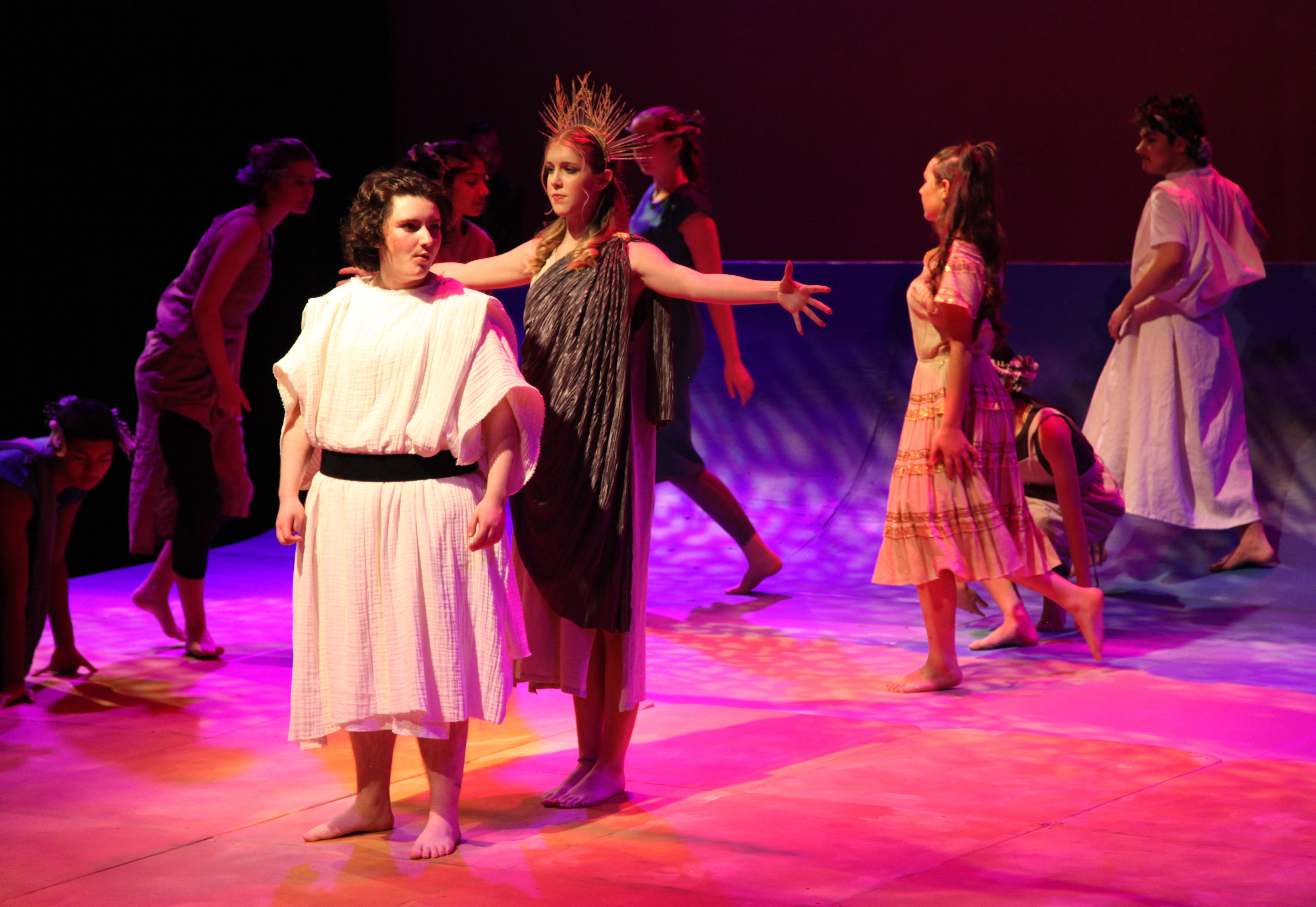
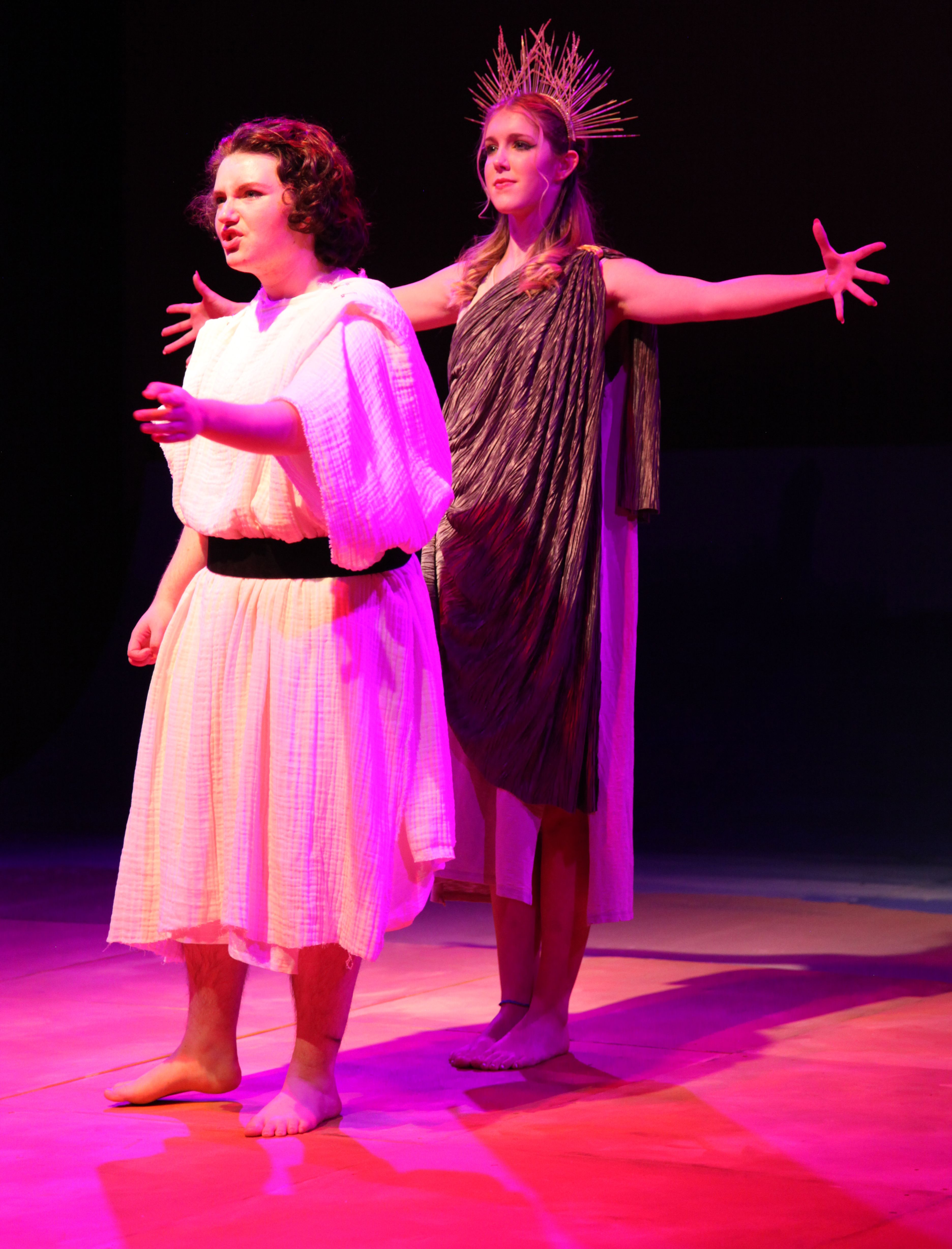
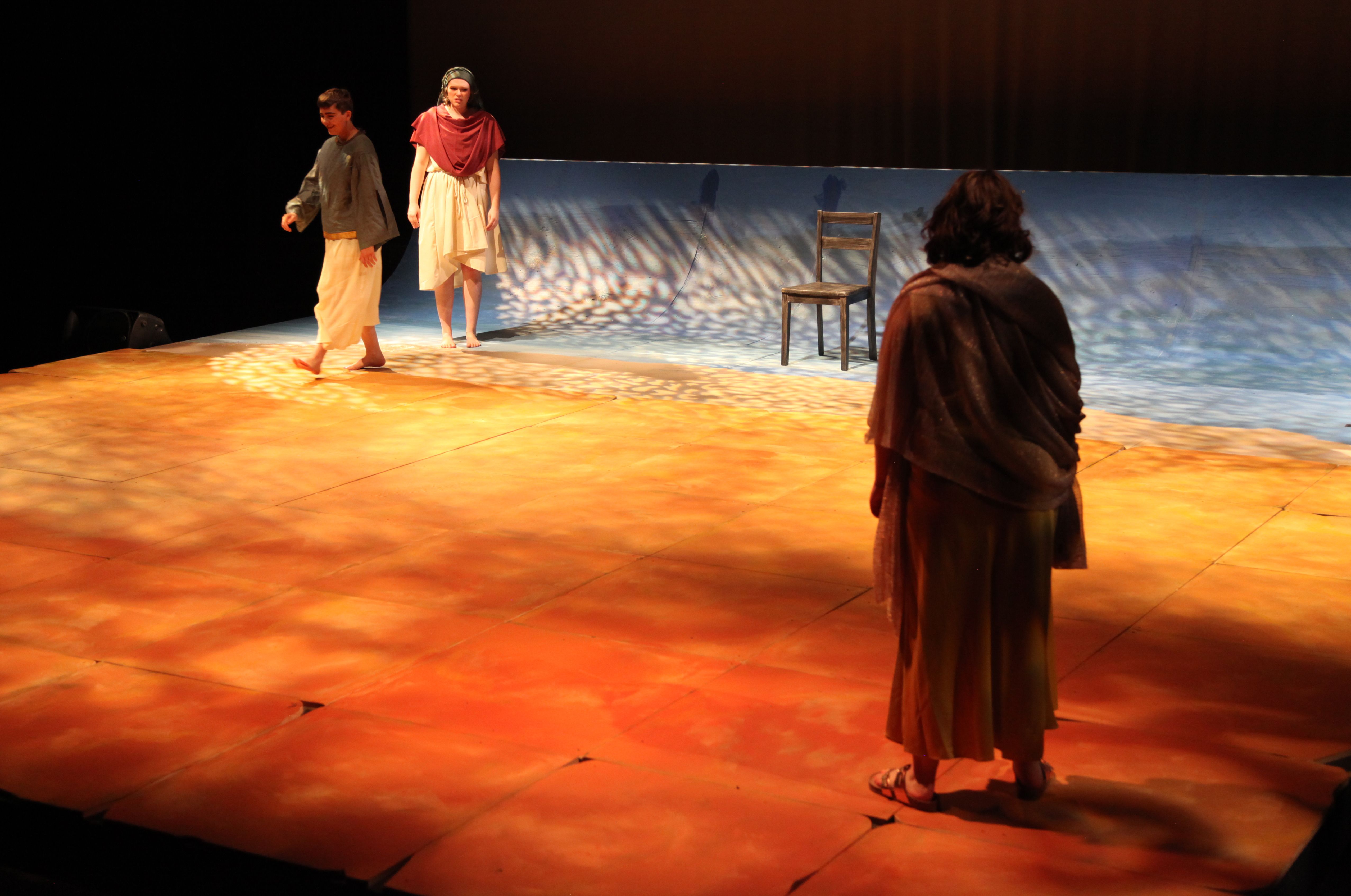
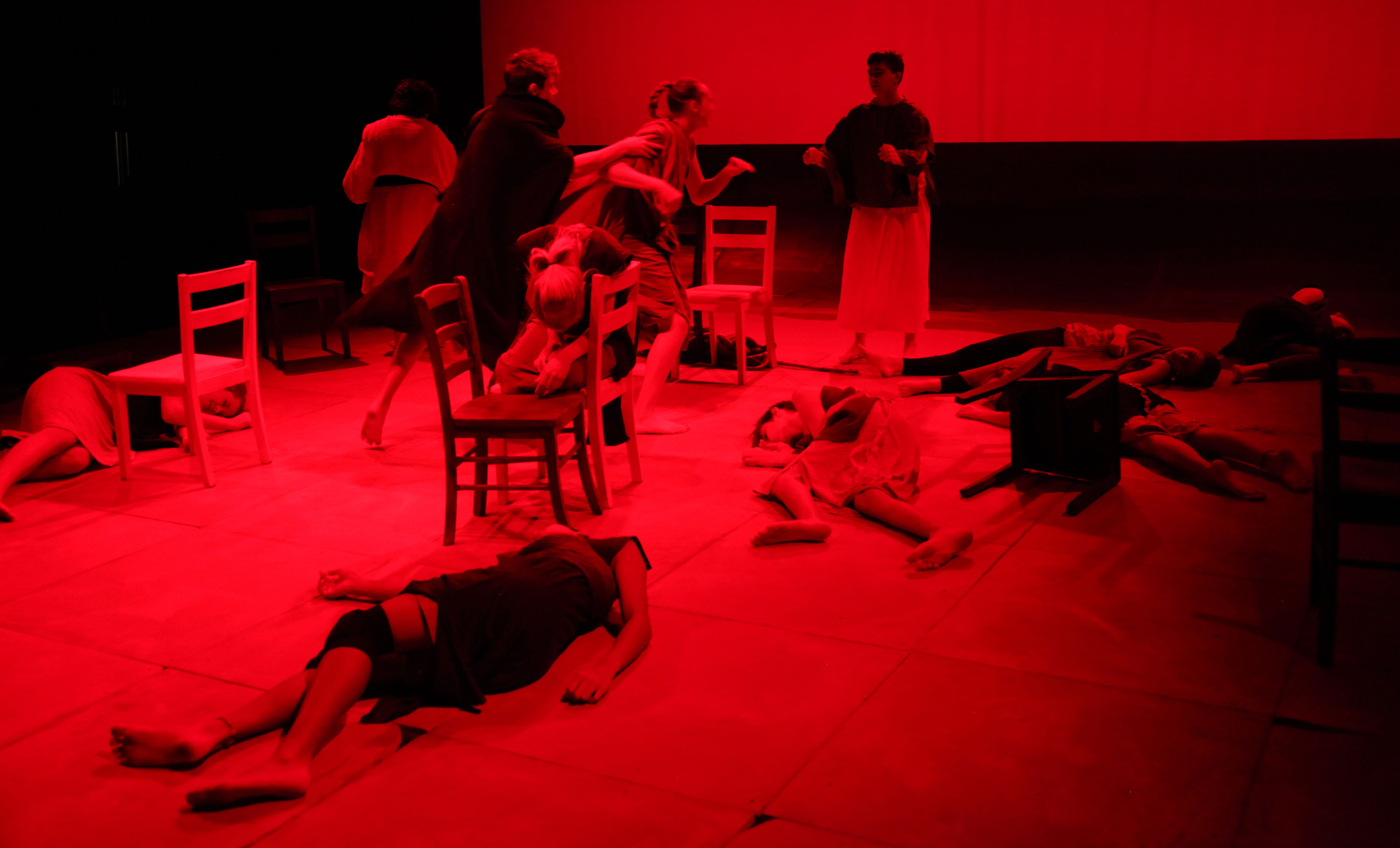
Since the wiggles can also adjust their beam spread from 11 degrees to 58 degrees, it's easy to create very tightly scoped spaces that my baseline grid system of front/side/side/back cannot accomplish.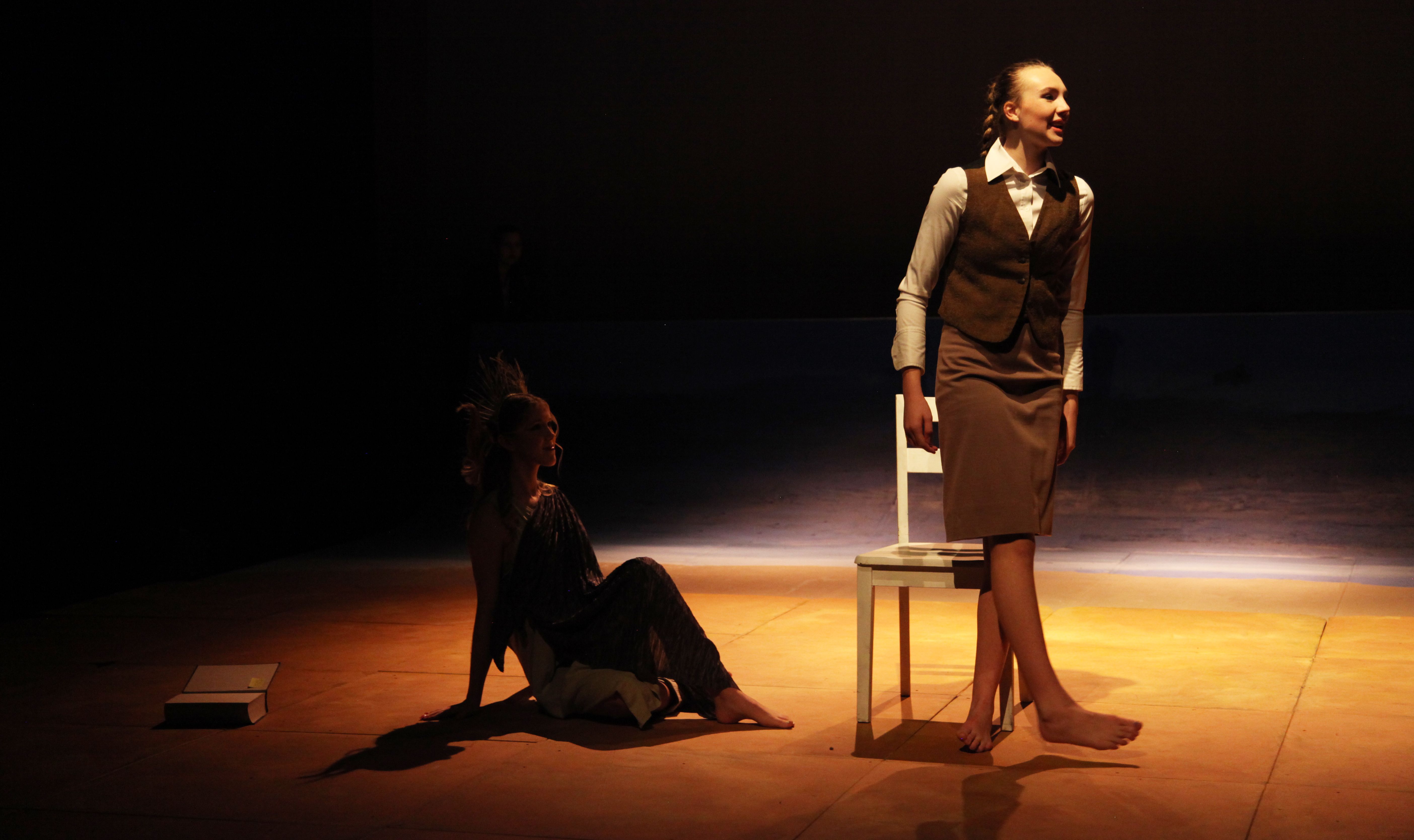
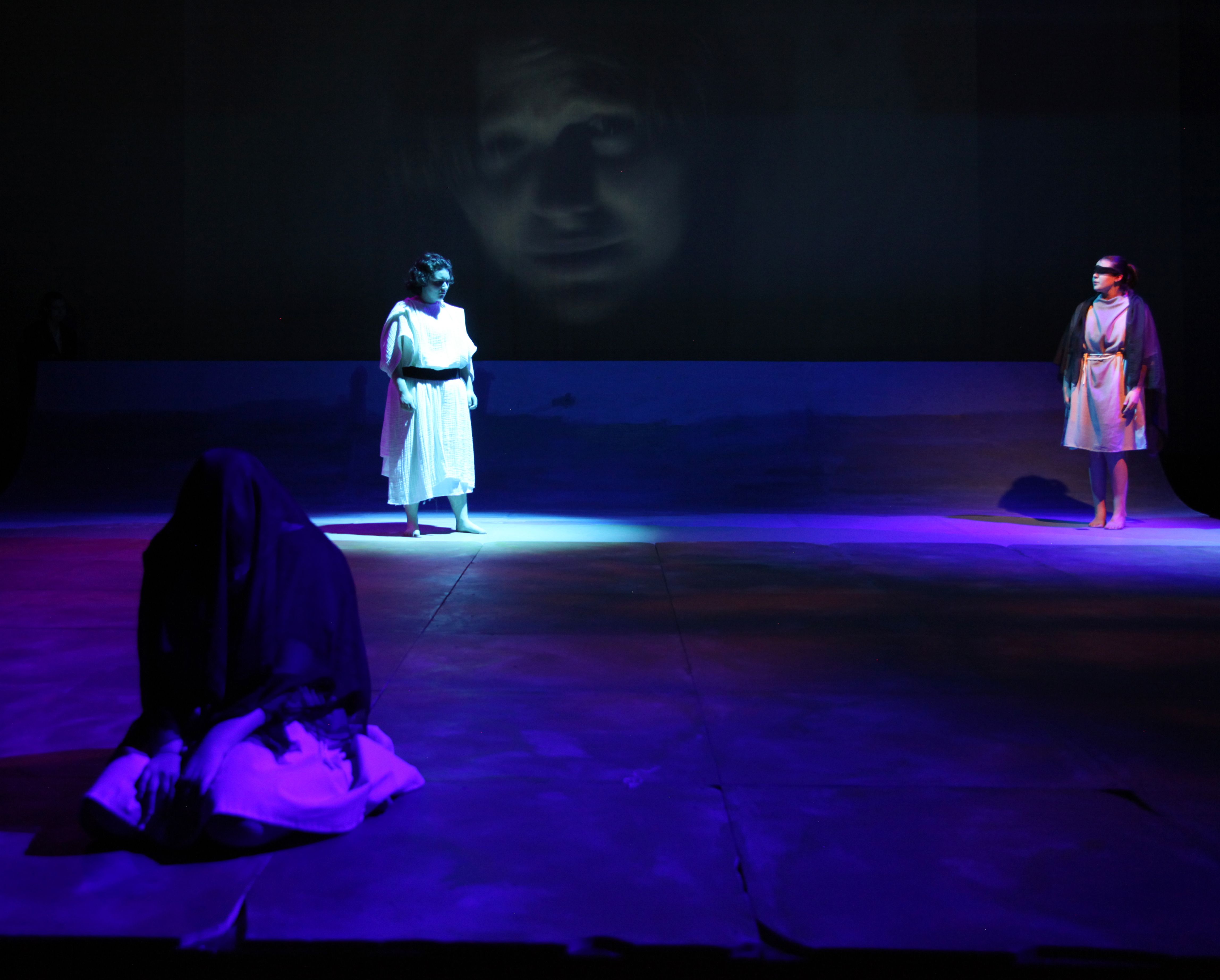
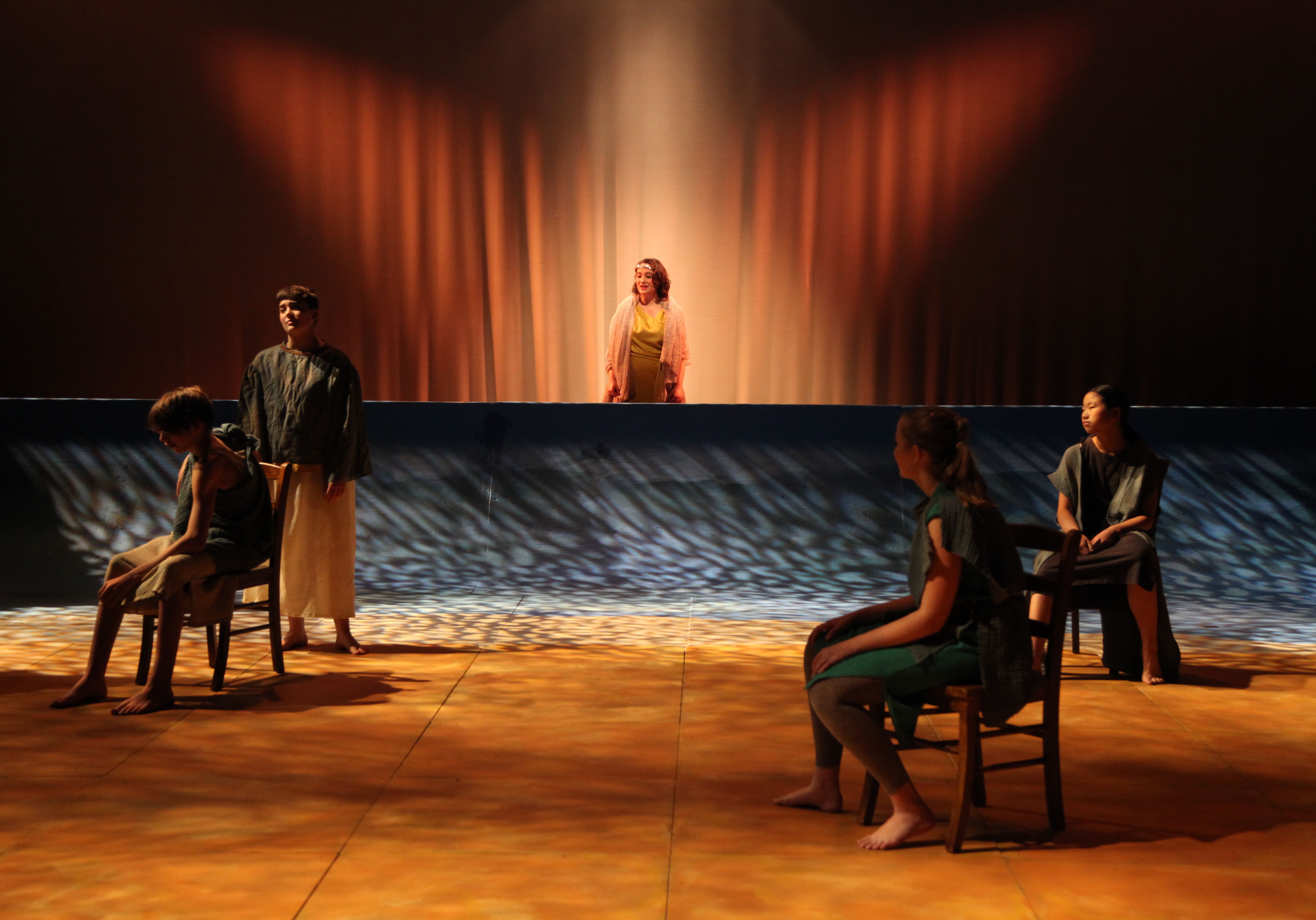
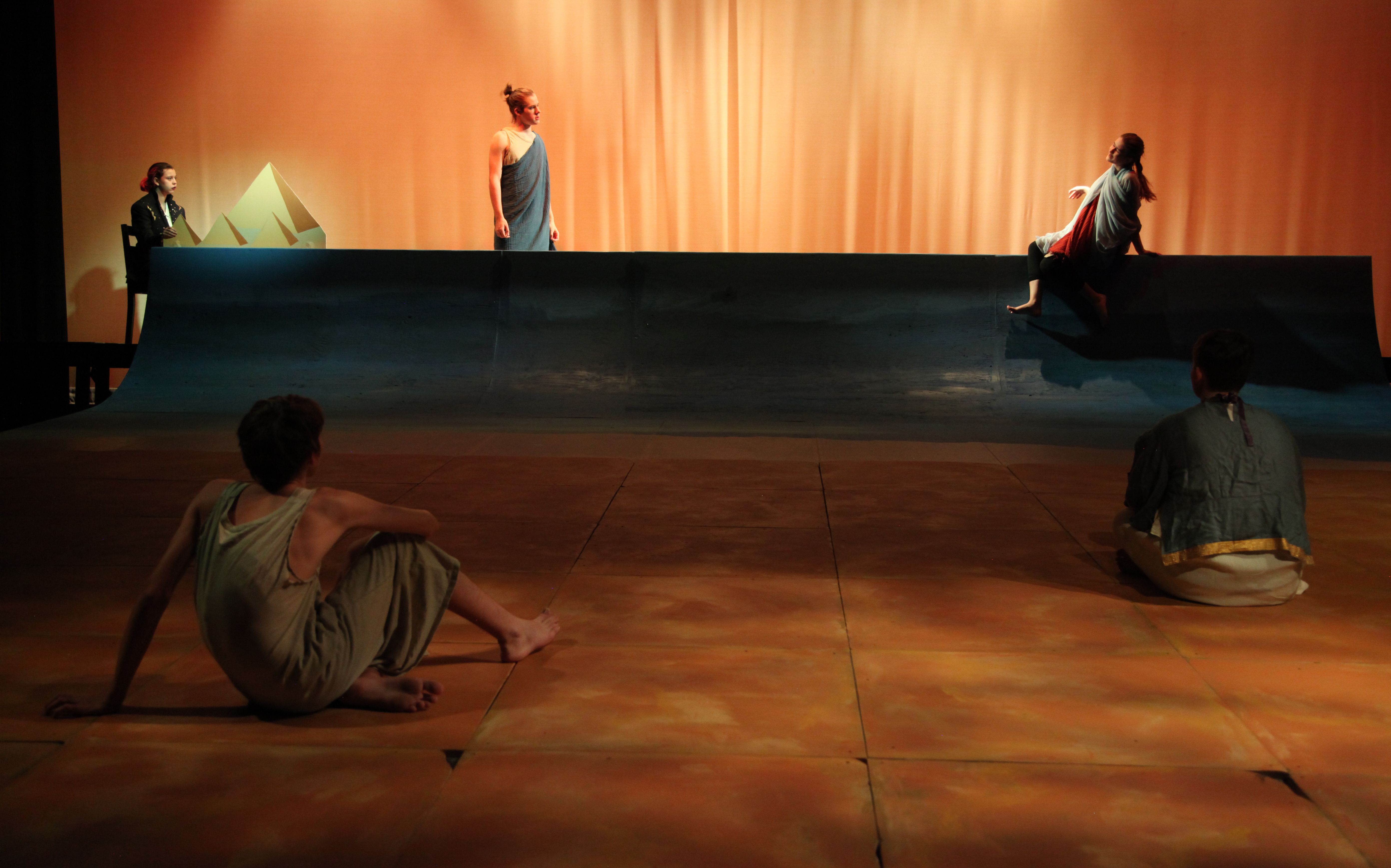
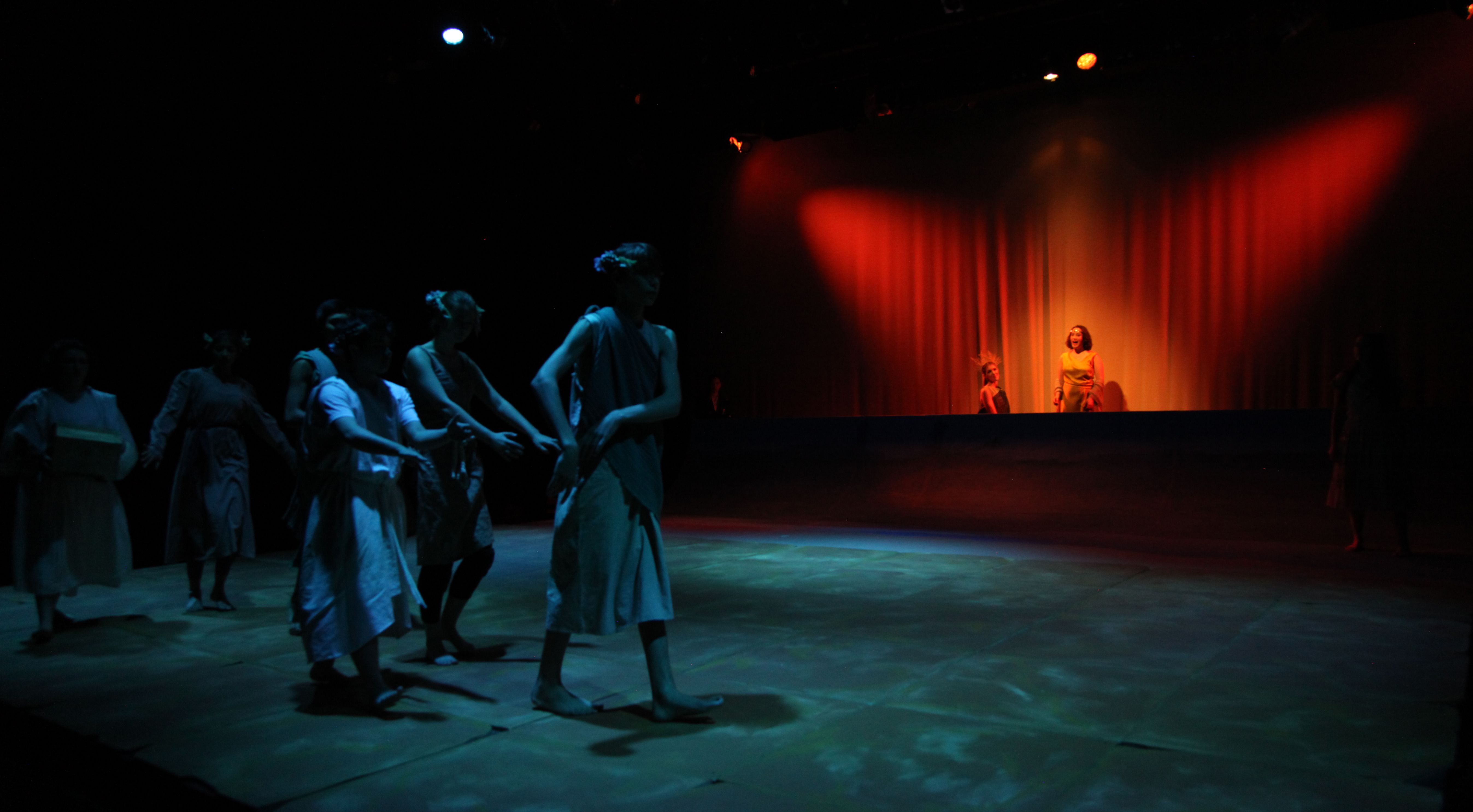
We're very happy with the outcome, though rather exhausted.
The aftermath
Since I'm actually writing this from the future, the year 2023, here's what happens next:
- Lydia, my lightboard operator, grows into being a full-fledged designer faster than I could have ever imagined.
- She and I co-design the next show (Peter and the Starcatcher). I bring in my light board and network it with the school's board (both ETC Elements) so she can see what I'm doing close-up while I write cues, and I can help her with hers, all without having to be on top of one another in a time of COVID peaking in the schools.
- She designs the third show of the season all on her own (I just design the rep plot) and she wins an award from Seattle's 5th Ave Theater for best student lighting design.
- Sarah and I continue working on the next two shows, spending a bit over 500 volunteer hours in the process. This gets us a gold medal and signed letter from US President Biden, the President's Volunteer Service Award. Completely unexpected, and not something I'd ever imagined doing in my life.
- Sarah becomes the teacher of the school's Theater Tech class and goes on to design and run more and more shows for them.
- The school administration somehow finds ~$50K to buy the theater an inventory of both fixed and moving LED lights based on a permanent rep plot I design for them, and I get to take my little MAC Auras home.
As much as this has set my filmmaking adventures back by over a year, this has been one of the most fulfilling adventures of my life. I came in to slap together yet another show and came out a changed person. I've discovered just how much I love teaching, and I've even gotten to teach a few stage design classes since (more on that later). +++ would buy again.
| « Questions about organizational culture | The Grip Truck » |